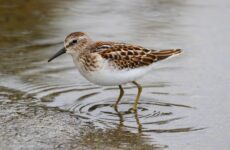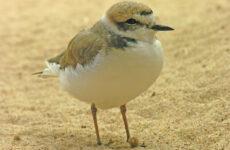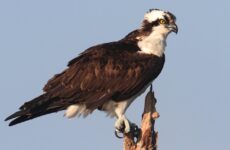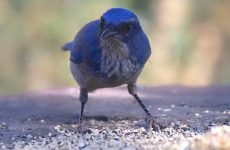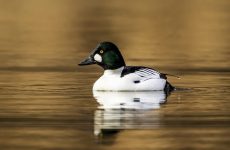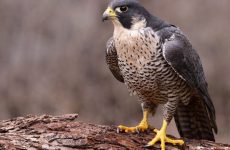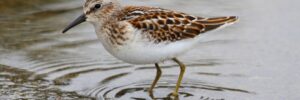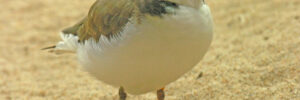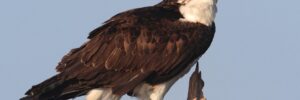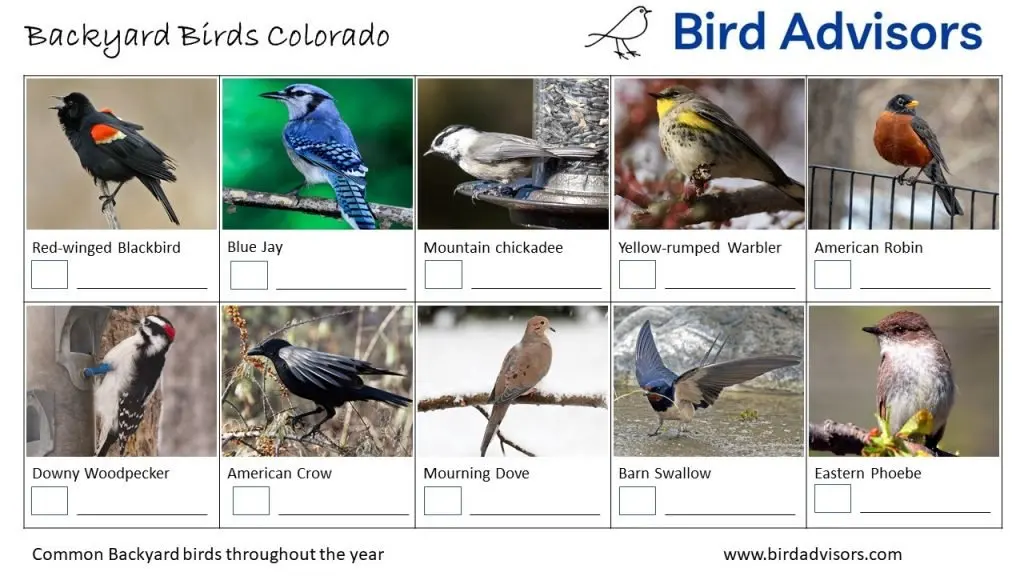
Have you wondered what those birds are that are visiting your backyard in Colorado?
Well, this guide will help you to find out how to identify these birds by sight and sound and what time of year you can spot them in Colorado. Also, get a free ID chart to print with the most common backyard birds in Colorado.
In Colorado American Robins, Mourning Doves, Broad-tailed Hummingbirds, and Yellow Warblers are more common in summer. Dark-eyed Juncos and Black-capped Chickadees are more common in winter.
Backyard birds in Colorado all year: House Finch, Northern Flicker, Black-capped Chickadee, Black-billed Magpie, American Crow, European Starling, Eurasian Collared-Dove, American Goldfinch, Blue Jay, Song Sparrow, House Sparrow, Downy Woodpecker, White-breasted Nuthatch, Spotted Towhee, White-crowned Sparrow
Backyard birds in Colorado in summer: American Robin, Mourning Dove, Broad-tailed Hummingbird, Red-winged Blackbird, House Wren, Barn Swallow, Yellow Warbler, Western Meadowlark, Common Grackle, Western Kingbird, Yellow-rumped Warbler, Chipping Sparrow, Lesser Goldfinch
Backyard birds in Colorado in winter: Dark-eyed Junco
These are the most common backyard birds in Colorado that may visit your lawn or feeders. They are the birds that appear most frequently on state checklists submitted by bird watchers on ebird.
This article gives you identification information and photos to help you identify and attract more of the common backyard birds that you can spot in Colorado.
If you like backyard birding you will probably enjoy spotting some ducks in Colorado too.
Facts About Birds in Colorado
The Lark Bunting is the state bird of Colorado. This bird was chosen in 1931 and is a migrant that arrives in April to the Plains. It nearly lost out to the Mountain Bluebird or Western Meadowlark, but this unlikely bird won through.
There are 507 species of bird recorded in Colorado, according to ebird. Some of the highlight birds in Colorado include Ferruginous Hawk, Mountain Bluebird, Golden Eagle, Bald Eagle, White Pelican, White-faced Ibis, American Avocet, Burrowing Owl, Rough-legged Hawk, Great Blue Heron, and Greater Roadrunner.
The biggest bird in Colorado is the Bald Eagle, with a wingspan of up to 8 feet (2.5 m) for the females. This white-headed national bird symbol of the United States is a powerful bird of prey.
The smallest bird in Colorado is the Calliope Hummingbird which is only about 3 in long, but they can travel long distances from Canada all the way to southern Mexico.
The most common bird in Colorado is the American Robin, which is seen in 39% of recorded checklists for the state on ebird throughout the year.
Colorado has 4 national parks, 11 national forests, 8 national wildlife refuges, 2 national grasslands, and 42 state parks that offer excellent bird watching opportunities if you want to get out and watch birds in their natural environment.
Read to the end of this article to find out more about the other birds you may be able to spot if you go out birding in Colorado and how to attract and identify birds.
Free Printable Backyard Birds Worksheet for Colorado
These free bird identification worksheets have all the common backyard birds in Colorado at different times of the year. So when you want to do some backyard birding, these handy guides have pictures and space to either tick off the types of birds you have seen or keep a tally of the total number of birds in Colorado you see.

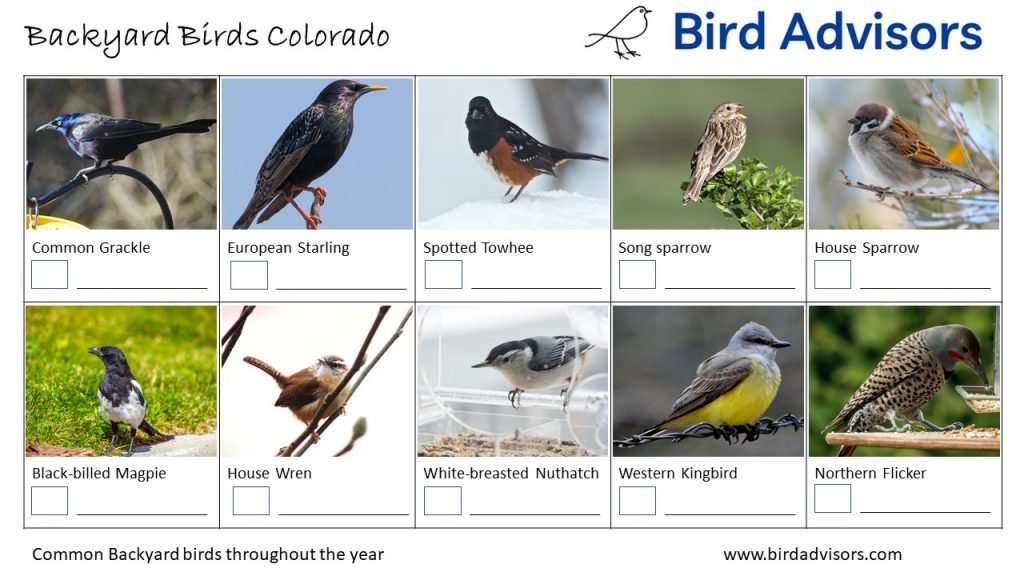
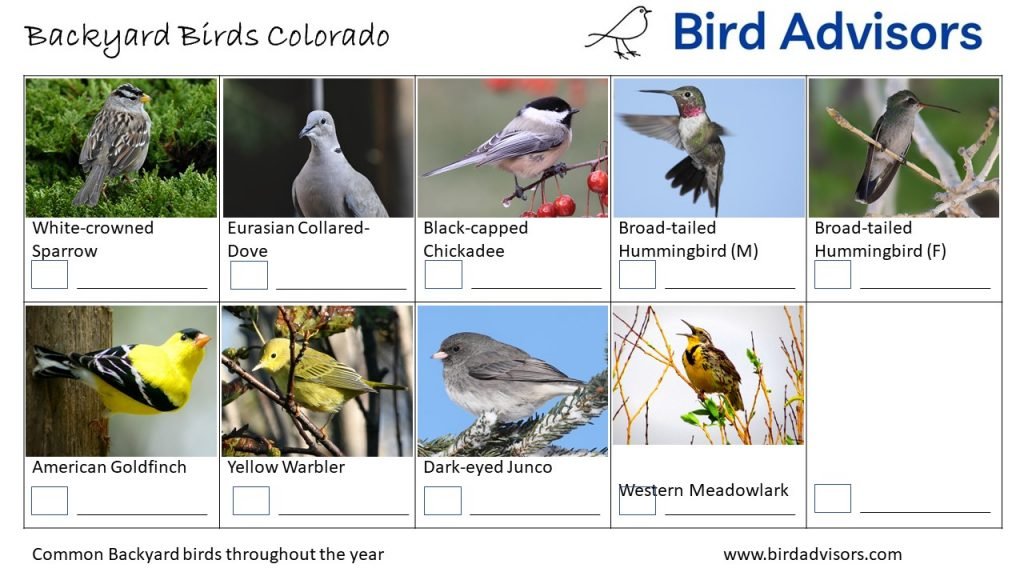
Top 30 Backyard Birds In Colorado:
1. American Robin
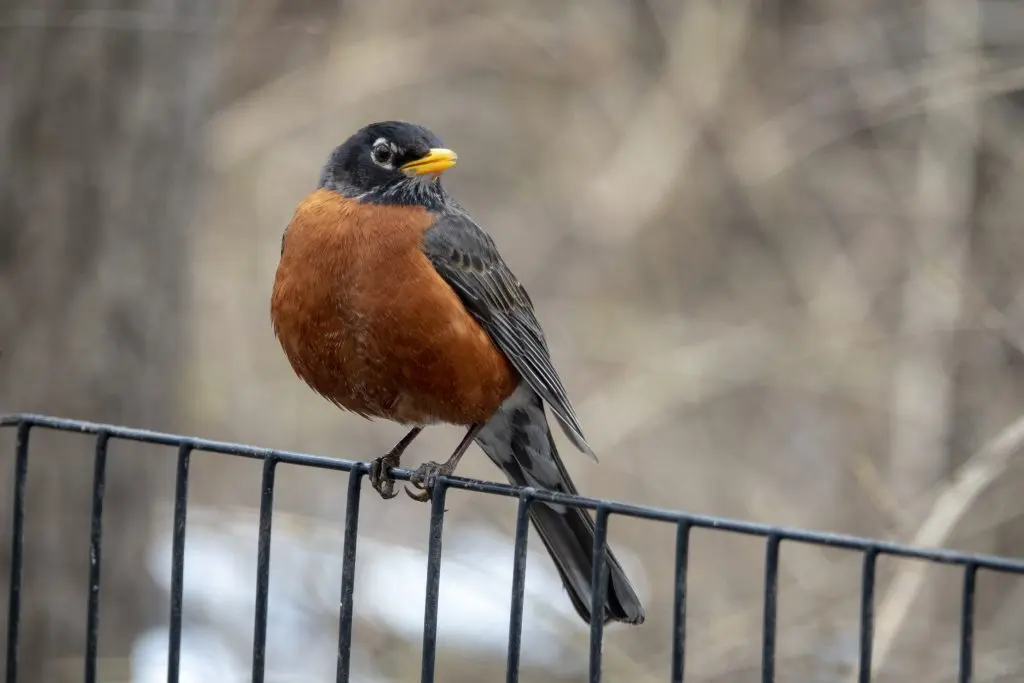
American Robins are spotted all year in eastern Colorado, but they are more common during the breeding season in the east of the state. They appear in 54% of summer checklists and 22% of winter checklists submitted by bird watchers for the state.
American Robins are a common sight on lawns eating earthworms. They have black heads and backs with red or orange breasts. They tend to roost in trees in winter, so you are more likely to see them in your backyard from spring.
- Turdus migratorius
- Length: 7.9-11.0 in (20-28 cm)
- Weight: 2.7-3.0 oz (77-85 g)
- Wingspan: 12.2-15.8 in (31-40 cm)
American Robins are residents in the lower 48 and the coast of Western Canada and Alaska. Those that breed in Canada and inland Alaska move south for the winter.
American Robins can be found in many habitats, from woodlands, forests, mountains to fields, parks, and lawns. They eat earthworms, insects, snails, and fruit.
American Robin Song:
American Robin Call:
Attract American Robins to your backyard with sunflower seeds, suet and peanut hearts, fruit, and mealworms. Platform feeders are best or food scattered on the ground. Also, try planting some native plants that produce berries, such as juniper, sumac, hawthorn, and dogwood.
2. Mourning Dove
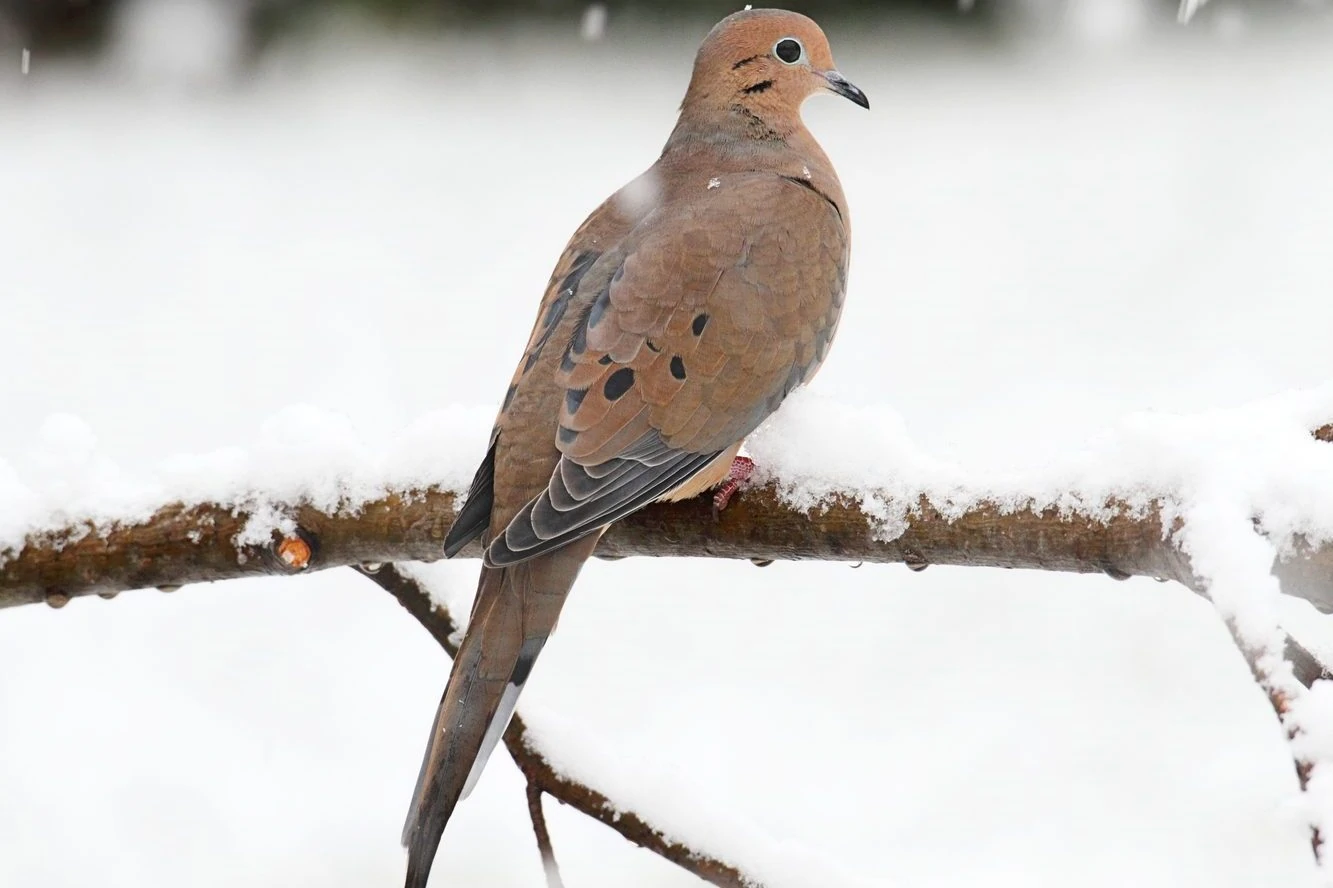
Mourning Doves are more frequently spotted in Colorado during the breeding season from April to October but some also stay in the east of the state all year. They are recorded in 38% of summer checklists and 4% of winter checklists.
Mourning Doves are graceful small-headed birds with plump bodies and long tails. They are a soft brown color with black spots on the wings. Males are slightly heavier than females.
- Zenaida macroura
- Length: 9.1-13.4 in (23-34 cm)
- Weight: 3.0 -6.0 oz (96-170 g)
- Wingspan: 17.7 in (45 cm)
Mourning Doves are common over all of the lower 48 all year but may migrate after breeding from the north of the Midwest and southern Canada.
Mourning Doves can be seen perching on telephone wires and foraging for seeds on the ground in grasslands, fields, and backyards. They can also be found in open areas or woodland edges.
Mourning Dove call:
Attract Mourning Doves to your backyard by scattering millet on the ground or platform feeders. They will also eat black sunflower seeds, nyjer, cracked corn, and peanut hearts.
3. Broad-tailed Hummingbird
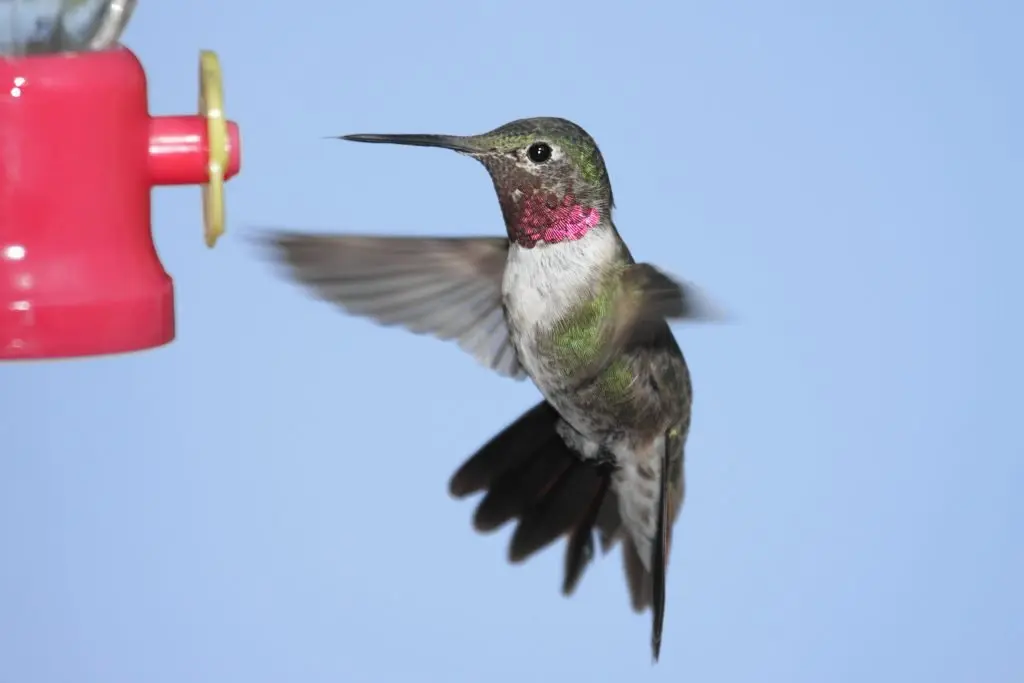
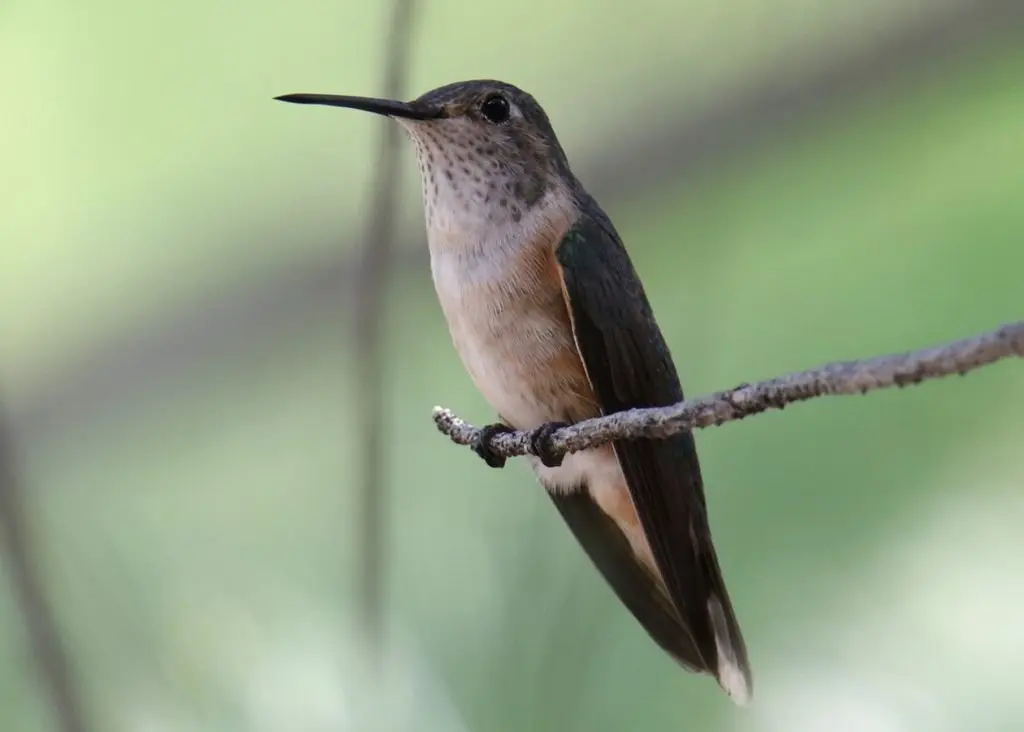
Broad-tailed Hummingbirds spend summer in Colorado and occur in 28% of checklists at this time. They arrive as early as March and start to migrate in September.
Broad-tailed Hummingbirds live in higher elevations and are iridescent green on the back, brownish in the wings, and white on the chest and into the belly. Males have an iridescent rose throat, females and juveniles have green spots on their throats and cheeks.
- Length: 3.1-3.5 in (8-9 cm)
- Weight: 0.1-0.2 oz (2.8-4.5 g)
Broad-tailed Hummingbirds breed in high meadows and open woodlands between 5,000 – 10,000 feet elevation in the mountainous west, between late May and August between central Idaho, southern Montana, northern Wyoming, and south to California
Migration south is to southern Mexico for winter but some Broad-tailed Hummingbirds may stay on the Gulf Coast. Migration of Broad-tailed Hummingbirds occurs in April and late August and September
Due to the cold at higher elevations, the Broad-tailed Hummingbird can slow their heart rate and drop their body temperature to enter a state of torpor.
Nectar from flowers is the usual food of hummingbirds and Broad-tailed Hummingbirds drink from larkspur, red columbine, sage, scarlet gilia and they will also come to hummingbird nectar feeders. They supplement their diet with small insects and will feed their young on insects too.
Broad-tailed Hummingbird nests are usually on evergreen or aspen branches and are made with spider webs and gossamer under overhanging branches for added insulation during cold nights.
If you get a buzz out of hummingbirds then check out all the hummingbirds in Colorado and when is best to spot them.
4. Red-winged Blackbird
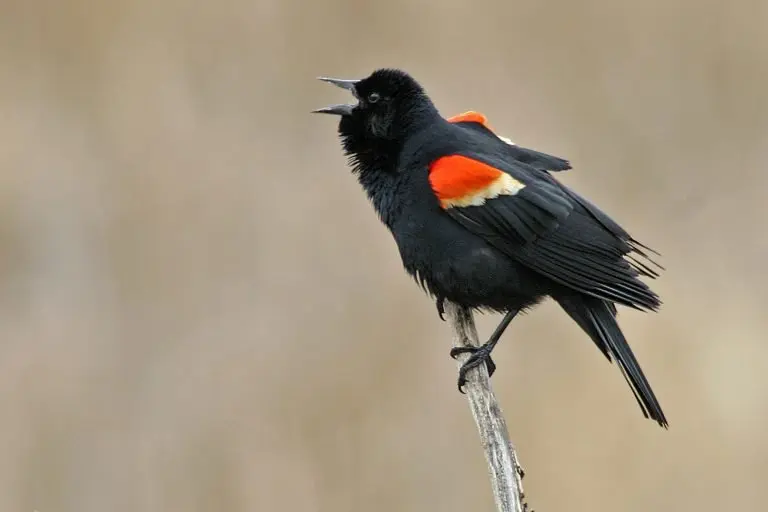
Red-winged blackbirds are the more frequently spotted in Colorado during summer but they also hang around in the east of the state all year. They appear in 38% of checklists in summer and 18% of checklists in winter submitted by bird watchers for the state.
Red-winged blackbirds are very common and easy to identify with the all-black coloring except for the reddish-orange wing patches. Females are rather dull in comparison with streaky brown color.
- Agelaius phoeniceus
- Length: 6.7-9.1 in (17-23 cm)
- Weight: 1.1-2.7 oz (32-77 g)
- Wingspan: 12.2-15.8 in (31-40 cm)
Red-winged Blackbirds remain all year in the lower 48 and the Pacific Coast of British Columbia. Those that breed in Canada and some northern US states migrate south for the winter.
They can often be spotted sitting on telephone wires, and the males will fiercely defend their territories in the breeding season, even attacking people that get too close to nests. In winter, they roost in large numbers into the millions.
Red-winged Blackbird Song:
Red-winged Blackbird Calls:
Attract Red-winged blackbirds to your backyard with mixed grain and seeds spread on the ground. They will also feed from large tube feeders or platform feeders.
Blackbirds are a vast family of birds that have numerous family members and why don’t you get to know all the blackbirds in Colorado?
5. Dark-eyed Junco
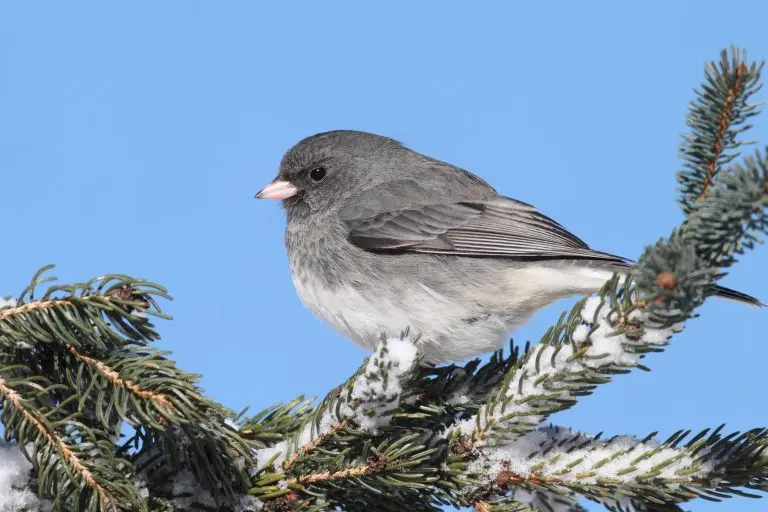
Dark-eyed Juncos are frequently spotted during winter in Colorado and are recorded in 57% of checklists at this time. They are mostly seen from October to March, but some can be spotted all year and occur in 9% of summer checklists.
Dark-eyed Juncos are sparrows that are different colors depending on the state. They are generally slate-colored in the east and black, white, and brown in the west.
- Junco hyemalis
- Length: 5.5-6.3 in (14-16 cm)
- Weight: 0.6-1.1 oz (18-30 g)
- Wingspan: 7.1-9.8 in (18-25 cm)
Dark-eyed Juncos remain resident all year in northeastern and western US states and the Appalachian Mountains. Those that breed in Canada and Alaska migrate south in winter to the United States.
They can be found in open and partially wooded areas, often on the ground, and are common across the continent.
Dark-eyed Junco Song:
Attract Dark-eyed Juncos to backyard feeders with a variety of seeds such as black oil sunflower seeds, nyjer, cracked corn, millet, and peanuts. Platform feeders or scattered on the ground is best.
6. House Finch
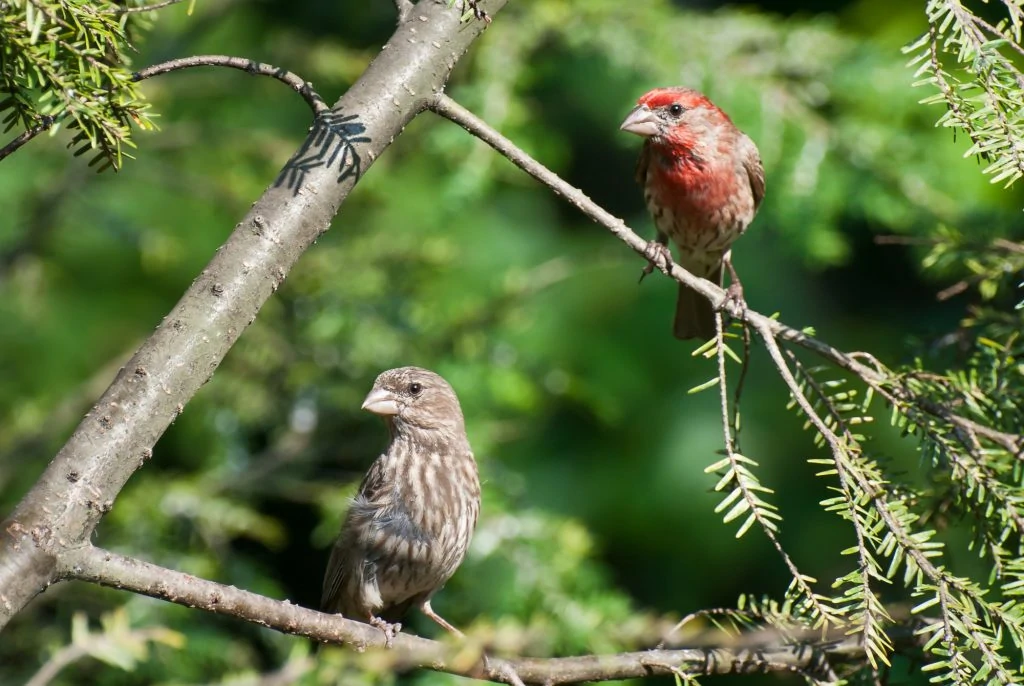
House Finches are residents of Colorado all year. They do not migrate and appear in 33% of summer checklists and 38% of winter checklists submitted by bird watchers for the state.
House Finches males have a red head and breast, and the rest of their bodies are mainly brown-streaked. Females are brown-streaked all over.
- Haemorhous mexicanus
- Length: 5.1-5.5 in (13-14 cm)
- Weight: 0.6-0.9 oz (16-27 g)
- Wingspan: 7.9-9.8 in (20-25 cm)
Originally only in western US states, House Finches were introduced to eastern US states and have done very well, even pushing out the Purple Finch.
They can be found in parks, farms, forest edges, and backyard feeders in noisy groups that are hard to miss.
House Finch Song:
House Finch Call:
Attract House Finches to backyard feeders with black oil sunflower seeds or nyjer seeds in tube feeders or platform feeders.
There are lots of other red birds in Colorado that you can spot.
7. Northern Flicker
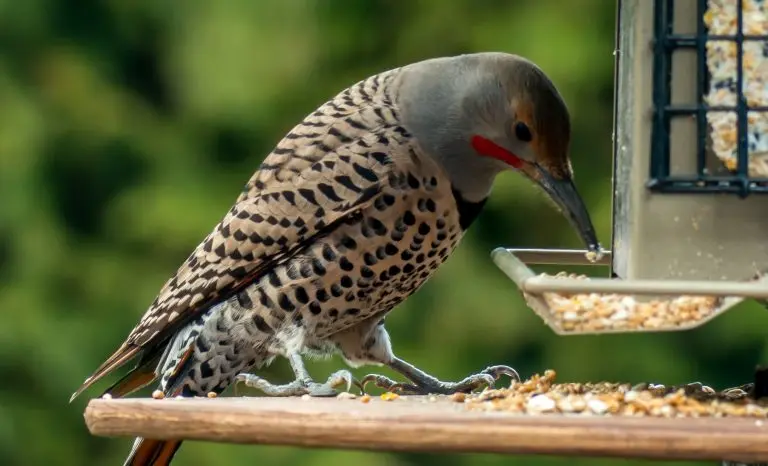
Northern Flickers are spotted in western Colorado during the breeding season but they live in the east of the state all year. They appear in 30% of summer checklists and 35% of winter checklists.
Northern Flickers are large brown woodpeckers with black spots and a white patch on their rump in flight, plus a red nape of the neck in the males.
Northern Flickers have red or yellow flashes in the wings and tail depending on where they originate. Red-shafted birds live in the west, and yellow-shafted birds live in the east.
- Colaptes auratus
- Length: 11.0-12.2 in (28-31 cm)
- Weight: 3.9-5.6 oz (110-160 g)
- Wingspan: 16.5-20.1 in (42-51 cm)
Northern Flickers can be spotted across the US all year and in Canada during summer. Those that breed in Canada migrate south for the winter.
Northern Flickers mainly eat ants, beetles, fruits, and seeds, and they can often be seen on the ground digging with their curved bill.
Northern flicker Call:
Attract Northern Flickers to your backyard with suet.
Some woodpeckers are more easily recognized than others, but with this guide, you can identify all the woodpeckers in Colorado.
8. Black-capped Chickadee
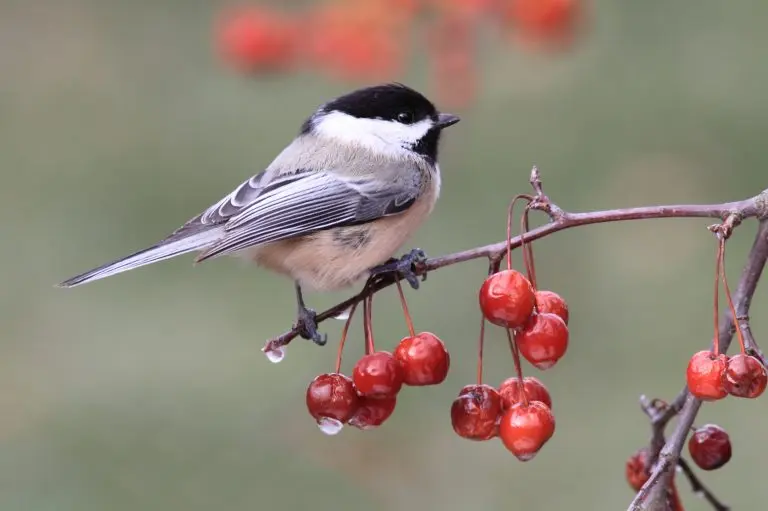
Black-capped Chickadees are residents of Colorado all year and are mostly seen in the west of the state. They are spotted in 23% of summer checklists and 35% of winter checklists.
The Black-capped Chickadee is a cute bird with a big round head and tiny body. These birds will happily feed at backyard feeders and investigate everything, including you!
They have black caps and beaks, white cheeks, and are gray on the back, wings, and tail.
- Poecile atricapillus
- Length: 4.7-5.9 in (12-15 cm)
- Weight: 0.3-0.5 oz (9-14 g)
- Wingspan: 6.3-8.3 in (16-21 cm)
Black-capped Chickadees do not migrate and can be spotted in the northern half of the US and Canada.
You can find them in forests, open woods, parks. Black-capped Chickadees eat seeds, berries and insects, spiders, and suet.
Black-capped Chickadee Call/Song:
Attract Black-capped Chickadees to your backyard with suet, sunflower seeds, and peanuts or peanut butter. They will even feed from your hand and are often one of the first birds to discover new feeders. They will also use nest boxes, especially if you fill them with wood shavings.
You should find out all about the other sociable and inquisitive chickadees in Colorado.
9. Black-billed Magpie
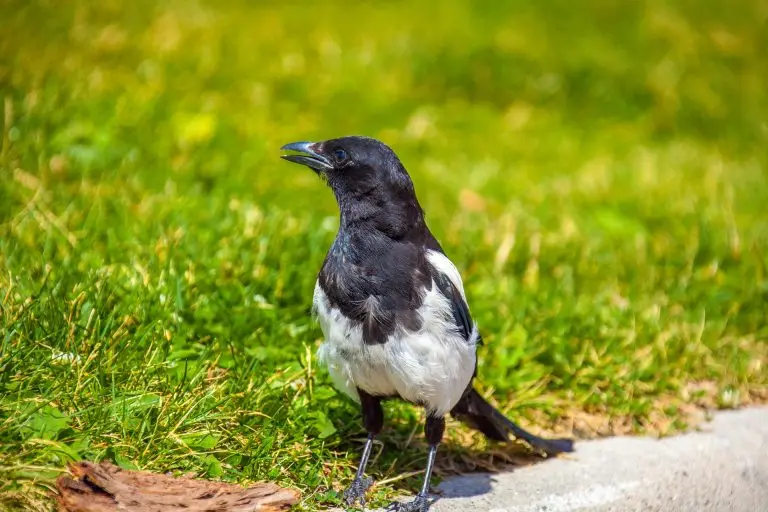
Black-billed Magpies are residents of Colorado all year. They do not migrate and occur in 26% of summer checklists and 33% of winter checklists for the state.
Black-billed Magpies, usually just called Magpies, are black and white birds that are noisy. They have long tails and blue-green iridescent flashes in the wing and tail. Males are up to 25% heavier than females.
- Pica hudsonia
- Length: 17.7-23.6 in (45-60 cm)
- Weight: 5.1-7.4 oz (145-210 g)
- Wingspan: 22.1-24.0 in (56-61 cm)
Black-billed Magpies live in northwestern US states and western Canada, and the coast of Alaska. They do not migrate.
You can find them walking on the ground in meadow and grasslands or other open areas feeding on fruit and grain, beetles, and grasshoppers. They have also been known to kill small mammals such as squirrels and voles and raid bird nests for eggs or nestlings and even carrion.
Black-billed Magpie sounds: A series of harsh calls and also a scream.
You can attract Black-billed Magpies to your backyard with platform and suet feeders with black oil sunflower seeds, peanuts, fruit, suet, millet, and milo.
10. House Wren
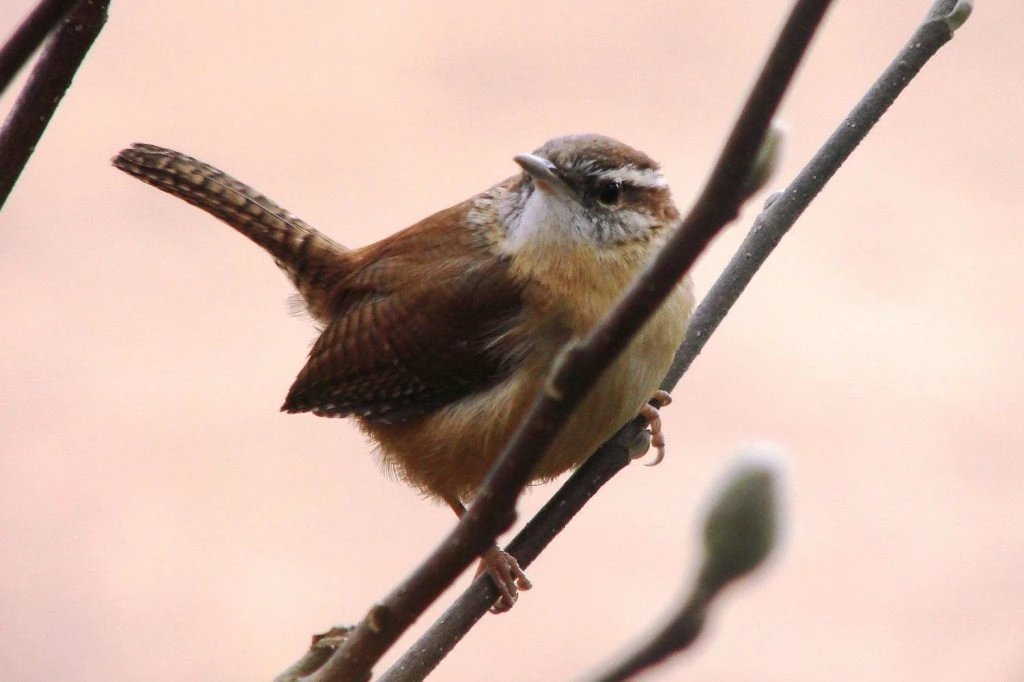
House Wrens can be seen in Colorado during the breeding season and appear in 30% of summer checklists. They are most likely to be spotted from April to October, and while most migrate south for the winter, a few can be spotted hanging around all year.
House Wrens are small nondescript brown birds with darker barred wings and tails and a paler throat.
- Troglodytes aedon
- Length: 4.3-5.1 in (11-13 cm)
- Weight: 0.3-0.4 oz (10-12 g)
- Wingspan: 5.9 in (15 cm)
House Wrens spend their summer breeding in the US and southern Canada before migrating to southern US states and Mexico for winter.
You can find House Wrens in backyards, parks and open woods foraging for insects and spiders. They can often be found energetically hopping through tangles and low branches with their tails up, stopping to sing their cheerful song.
House Wrens are fierce for their size when it comes to getting the best nest holes. They will often harass larger birds, sometimes dragging eggs or nestlings out of a nest site they want.
House Wren Song:
Attract House Wrens to your backyard by leaving piles of brush or putting up a nest box.
Wrens are often overlooked for more flash birds, but take the time to get to know the sight and sounds of wrens in Colorado.
11. American Crow
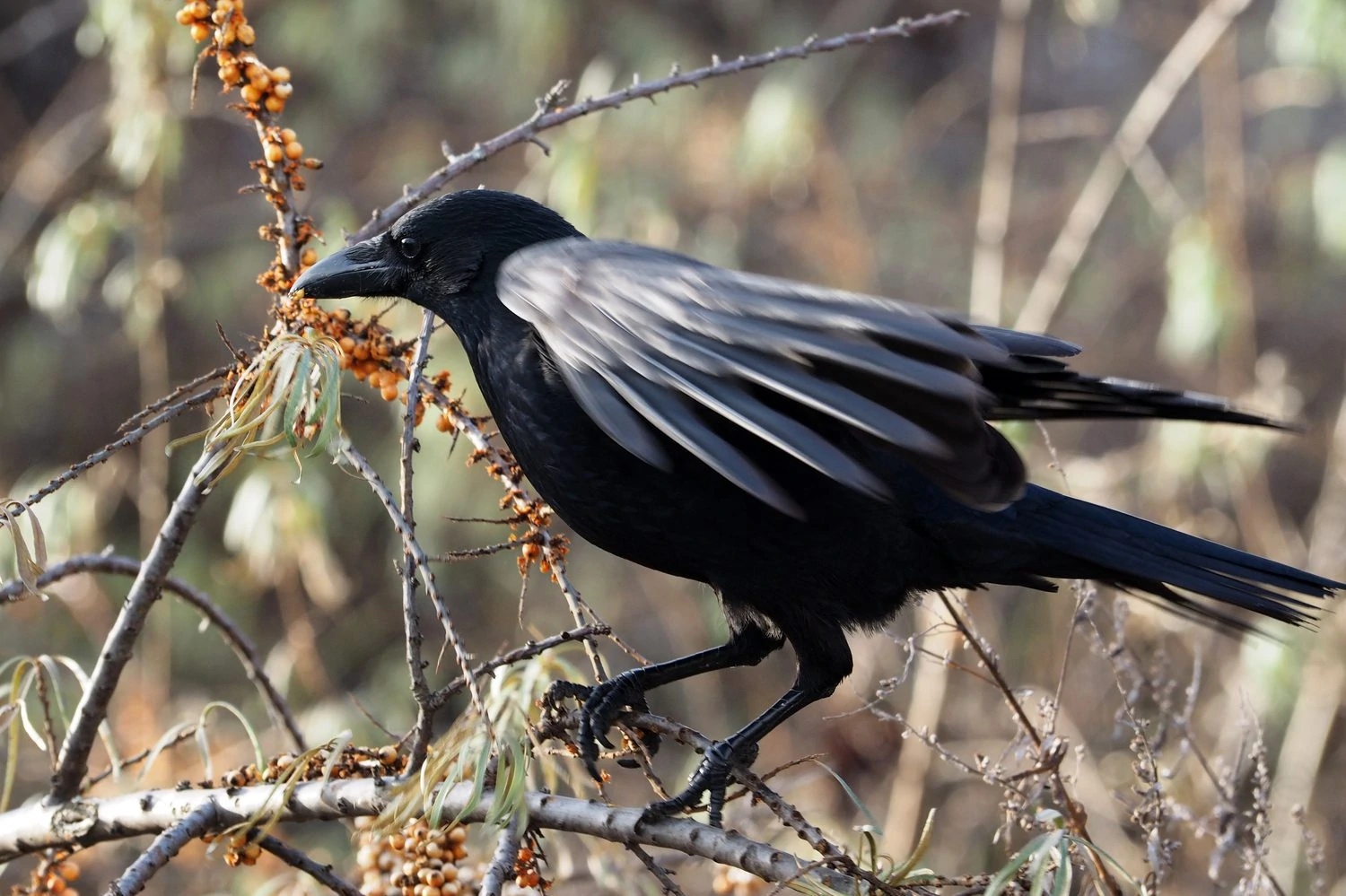
American Crows can be spotted all year in Colorado but their numbers increase during migrations in March and from mid-October to December. They appear in 21% of summer checklists, 29% of winter checklists, and up to 35% of checklists during migrations.
American crows are large all-black birds that make a hoarse, cawing sound.
- Corvus brachyrhynchos
- Length: 15.8-20.9 in (40-53 cm)
- Weight: 11.2-21.9 oz (316-620 g)
- Wingspan: 33.5-39.4 in (85-100 cm)
American Crows are residents all year in most of the lower 48 and the Pacific Coast in Canada and Alaska. Those that breed in Canada and the northern Midwest migrate south for winter.
They are common birds found in most habitats, including treetops, woods, fields, beaches, or towns.
They eat most things and usually feed on the ground, eating earthworms, insects, seeds, and fruit. They also eat fish, young turtles, mussels, and clams and will even eat eggs and nestlings of many species of birds.
In winter, American Crows gather in large numbers of up to two million crows to sleep in noisy communal roosts.
American Crow Call:
Attract American Crows to your backyard by scattering peanuts, but they can become a nuisance as they are attracted by garbage or pet food if left out.
12. European Starling
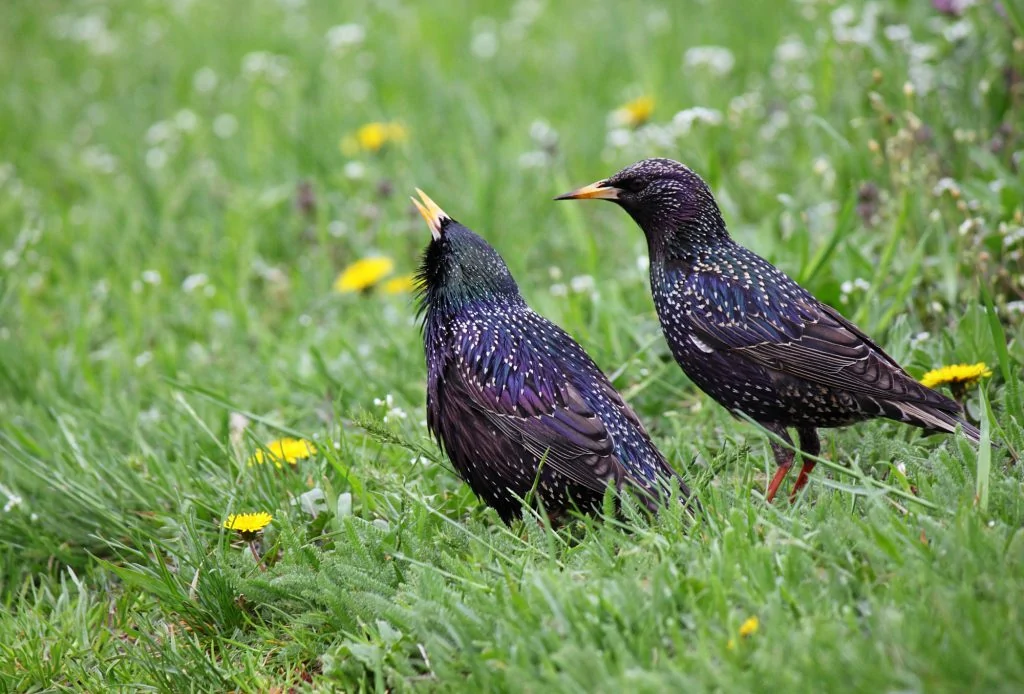
European Starlings are considered introduced species in Colorado that can be seen here all year. They appear in 23% of both summer and winter checklists submitted by bird watchers for the state.
European Starlings are not native but are now one of the most numerous songbirds. They are stocky black birds with iridescent purple, green, and blue tones.
- Sturnus vulgaris
- Length: 7.9-9.1 in (20-23 cm)
- Weight: 2.1-3.4 oz (60-96 g)
- Wingspan: 12.2-15.8 in (31-40 cm)
European Starlings live in all North America, except the north of Canada and Alaska.
They are considered a pest by some due to their aggressive behavior. These birds fly in large, noisy flocks and can be seen perched in groups on the top of trees or flying over fields.
European Starling Calls:
Starlings predominantly eat insects, including beetles, flies and caterpillars, earthworms, and spiders. However, they also eat fruit, including cherries, holly berries, mulberries, Virginia Creeper, sumac, blackberries, and grains and seeds.
Attract European Starlings to your backyard feeders with black oil sunflower seeds, suet, cracked corn, and peanuts.
13. Barn Swallow
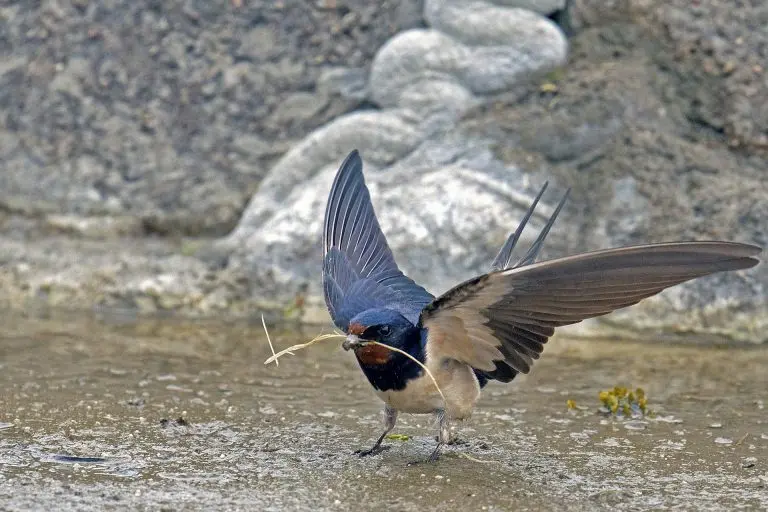
Barn Swallows spend the breeding season in Colorado and occur in 26% of summer checklists. They are seen in the state from March to November but are best spotted from April to October.
Barn Swallows are small birds with a deep-blue back, wings and tail, and reddish-brown underneath and across the face. Their tail has long outer feathers that give a deep fork. The dark color of their back can make them look black-and-white.
- Hirundo rustica
- Length: 5.9-7.5 in (15-19 cm)
- Weight: 0.6-0.7 oz (17-20 g)
- Wingspan: 11.4-12.6 in (29-32 cm)
Barn Swallows breed in Canada and the US before heading to Central and South America. They can be found flying over meadows, farms, and fields looking for insects and usually build mud nests on man-made structures such as in barns.
Barn Swallow call:
Attract Barn Swallows by putting up nest boxes or cups, and they may eat ground-up eggshells on a platform feeder.
14. Yellow Warbler
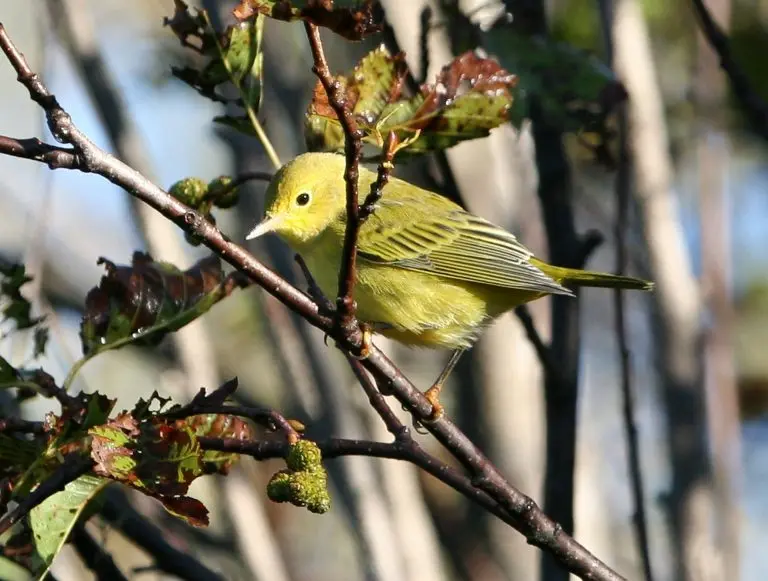
Yellow Warblers spend the breeding season in Colorado and are mainly spotted from May to September. They occur in up to 24% of summer checklists.
Yellow Warblers are small bright yellow birds with a yellow-green back, and the males have chestnut streaks on the breast.
- Setophaga petechia
- Length: 4.7-5.1 in (12-13 cm)
- Weight: 0.3-0.4 oz (9-11 g)
- Wingspan: 6.3-7.9 in (16-20 cm)
Yellow Warblers migrate a long distance to breed in Canada and the US, except for southeastern states, before heading back into Central and South America for winter. However, they can be seen during migration in southeastern US states.
You can find Yellow Warblers along streams and wetlands in thickets and along the edges of fields foraging for insects, including caterpillars, midges, beetles, bugs, and wasps.
Song
Attract Yellow Warblers to your backyard with suet, oranges, peanut butter, and plants with berries. Also, plant native plants that attract insects without pesticides or being too tidy! Also, try birdbaths with fountains near secluded thickets to provide protection.
There are so many yellow birds in Colorado that you will spot, especially in spring.
15. Western Meadowlark
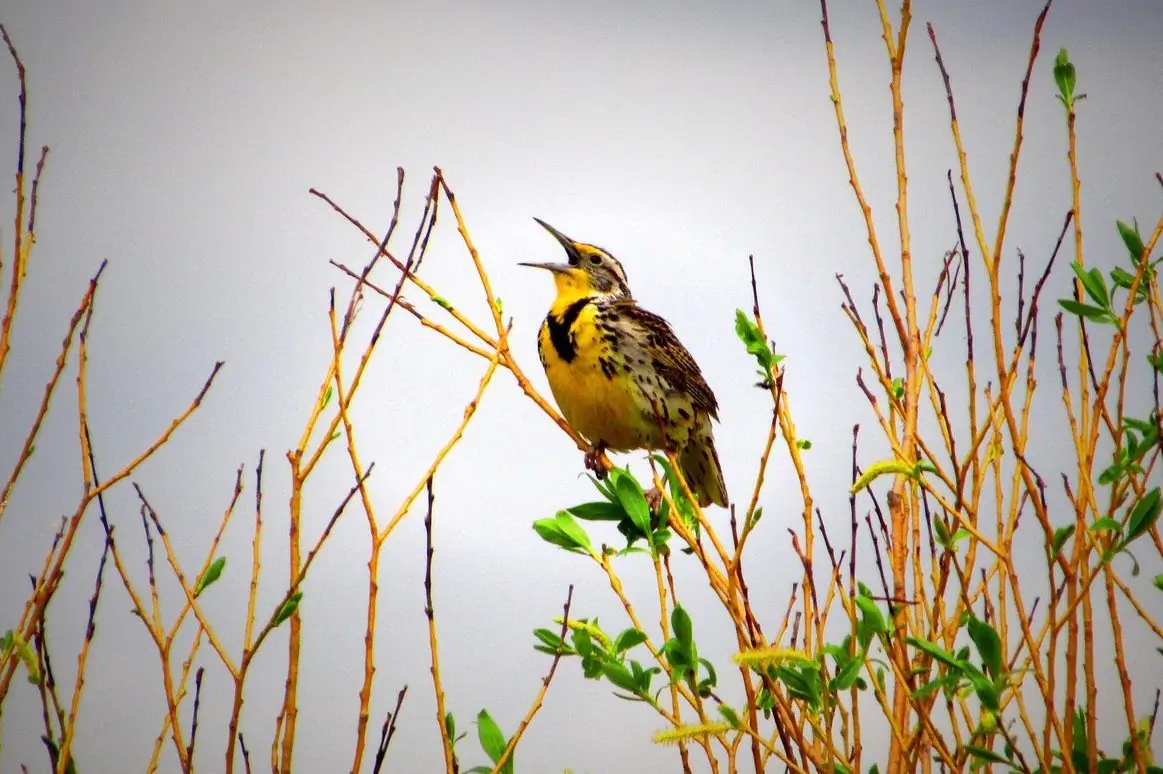
Western Meadowlarks are spotted all year in eastern Colorado, but they are more common in the west of the state during the breeding season. They are recorded in 25% of summer checklists and 4% of winter checklists.
With their bright yellow bellies and melodious song, Western Meadowlarks can brighten up your day. This is probably what makes them so popular, so popular in fact that they are the state bird of 6 US states.
Western Meadowlarks are members of the blackbird family and are about the size of a Robin with shades of brown and white upperparts and a black V-shaped band across the bright yellow chest that turns gray in winter.
- Sturnella neglecta
- Length: 6.3-10.2 in (16-26 cm)
- Weight: 3.1-4.1 oz (89-115 g)
- Wingspan: 16.1 in (41 cm)
Western Meadowlarks breed in northern US states and Canada before moving to more southern states. Those in The West and Midwest remain all year.
You can find Western Meadowlarks foraging for insects and seeds from weeds. Also, they look for seeds on the ground alone or in small flocks in grasslands, meadows, and fields.
Western Meadowlark Song:
Attract Western Meadowlarks to your backyard with hulled sunflower seeds and cracked corn.
16. Common Grackle
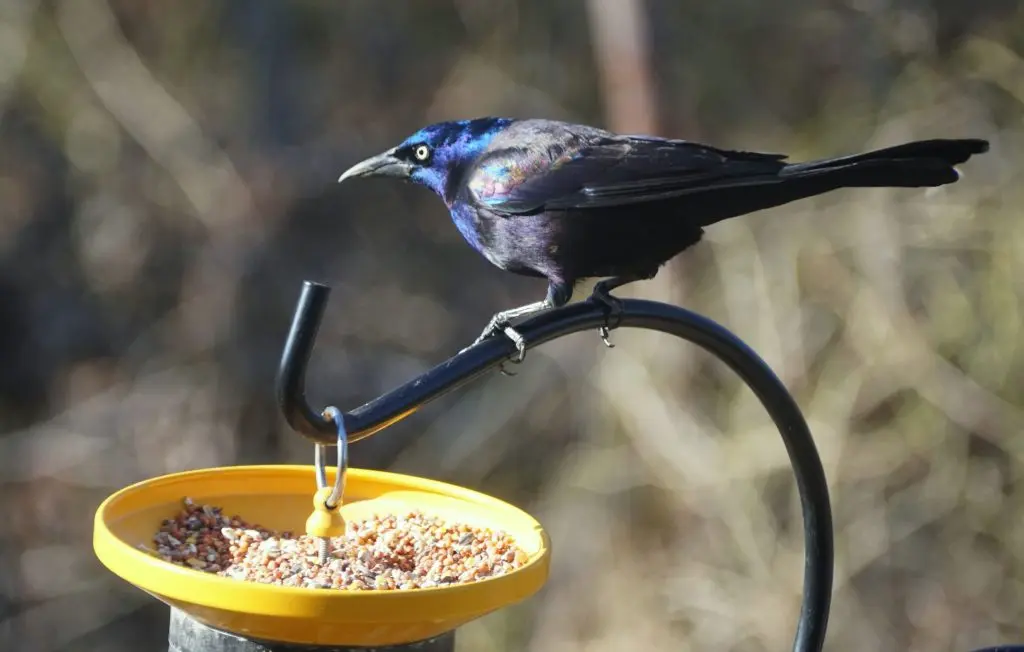
Although considered near-threatened species, Common Grackles are spotted during summer in Colorado and appear in 27% of checklists at this time. They spend the breeding season in the state and start arriving as early as March, and some stay all year, but April until September are the best months to spot them.
The Common Grackle is a blackbird taller and longer tailed than a typical blackbird with glossy iridescent bodies.
- Quiscalus quiscula
- Length: 11.0-13.4 in (28-34 cm)
- Weight: 2.6-5.0 oz (74-142 g)
- Wingspan: 14.2-18.1 in (36-46 cm)
Common Grackles are resident all year in southeastern states, but those that breed in Canada and the Midwest migrate south.
They eat many crops but mostly corn, and they gather in noisy groups high up in trees. Unfortunately, they will also eat garbage and so can be a nuisance. Their habitat is varied and includes open woodlands, marshes, parks, and fields.
They may gather in their millions in winter to forage and roost, mixed in with other species of blackbirds.
Common Grackle Call:
Attract more Common Grackles to your backyard with mixed grain and seed sprinkled on the ground or platform feeders.
17. Eurasian Collared-Dove
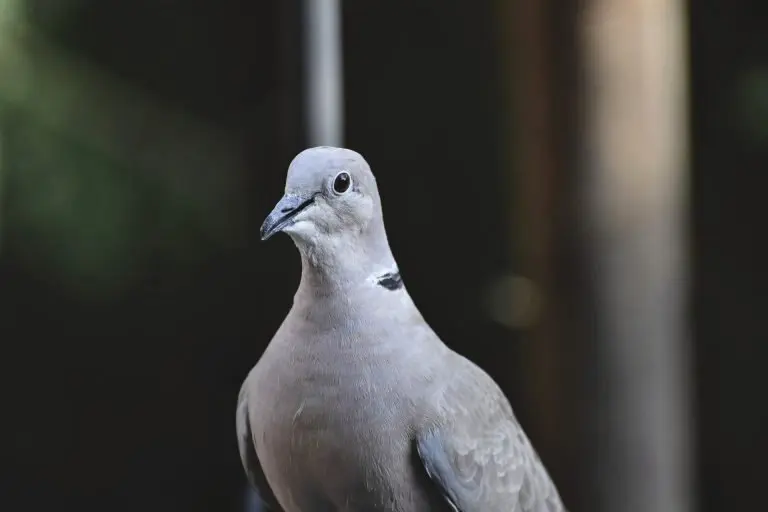
Eurasian Collared-Doves do not migrate and are residents of Colorado all year. They are recorded in 22% of summer and winter checklists for the state.
Eurasian-collard Doves are light brownish-gray, with white patches in the tail, and look very similar to Mourning Doves, but with a black half collar at the nape of the neck. They are also larger and with a square tail rather than pointed.
- Streptopelia decaocto
- Length: 11.4-11.8 in (29-30 cm)
- Weight: 4.9-6.3 oz (140-180 g)
- Wingspan: 13.8 in (35 cm)
Eurasian Collared-Doves are an introduced species that only arrived in the 1980s but now live across most of the United States.
You can find Eurasian Collared-Doves in most areas, including rural and suburban and they eat a wide variety of seeds and grain but also eat some berries and insects.
Eurasian Collared-Dove song:
18. Western Kingbird
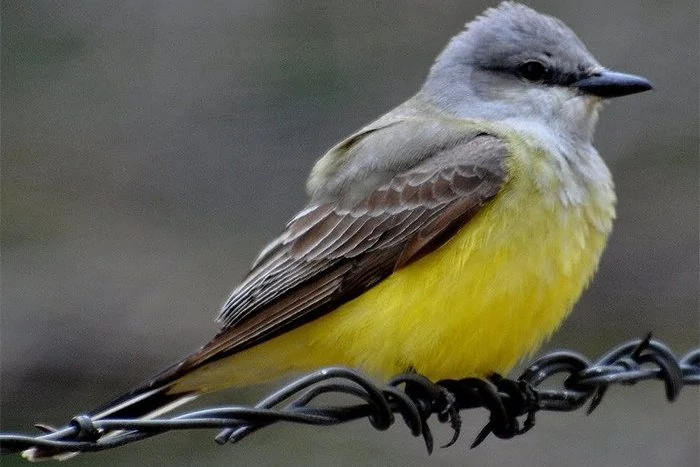
Western Kingbirds are mainly spotted in Colorado during summer from mid-April to September and occur in 20% of checklists at this time.
Western Kingbirds are large flycatchers with yellow bellies, whitish chests, gray heads, grayish-brown wings, and black tails with white edges.
- Tyrannus verticalis
- Length: 7.9-9.4 in (20-24 cm)
- Weight: 1.3-1.6 oz (37-46 g)
- Wingspan: 15.0-16.1 in (38-41 cm)
Western Kingbirds breed in summer in western US states, the plains area, and into Canada. They migrate to Mexico and Central America, but some may overwinter in the south of Florida.
You can find Western Kingbirds in open habitats, and they are often found perched on fences and utility lines, waiting for insects to fly by before catching them in mid-flight.
Western Kingbird call:
Attract Western Kingbirds to your yard by making it insect-friendly and planting elderberry or hawthorn, from which they will also eat the fruit.
19. American Goldfinch
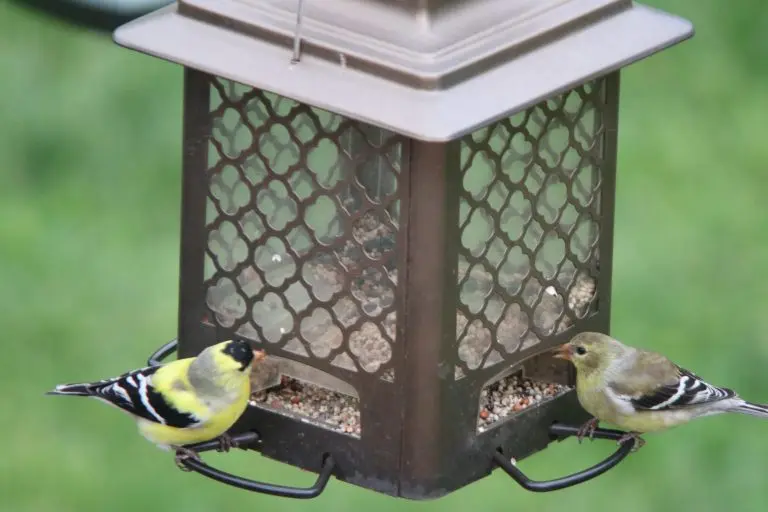
American Goldfinches stay in eastern Colorado all year, but they also breed in the west of the state. They are recorded in 19% of summer checklists and 13% of winter checklists for the state.
American Goldfinches are popular birds with the males bright yellow and black coloring in spring. The females are duller brown, as are males in winter.
- Spinus tristis
- Length: 4.3-5.1 in (11-13 cm)
- Weight: 0.4-0.7 oz (11-20 g)
- Wingspan: 7.5-8.7 in (19-22 cm)
American Goldfinches can be found in most of North America and are usually resident all year. However, those that breed in Canada and the Midwest migrate to southern US States for winter.
They can be found in weedy fields and overgrown areas foraging for sunflower, thistle, and aster plants. They are also common in suburbs, parks, and backyards.
American Goldfinch Song:
Attract American Goldfinches to your backyard by planting thistles and milkweed. They will visit most bird feeders and prefer sunflower seed and nyjer seed.
There are a surprising number of finches in Colorado that you can get to know.
20. Blue Jay
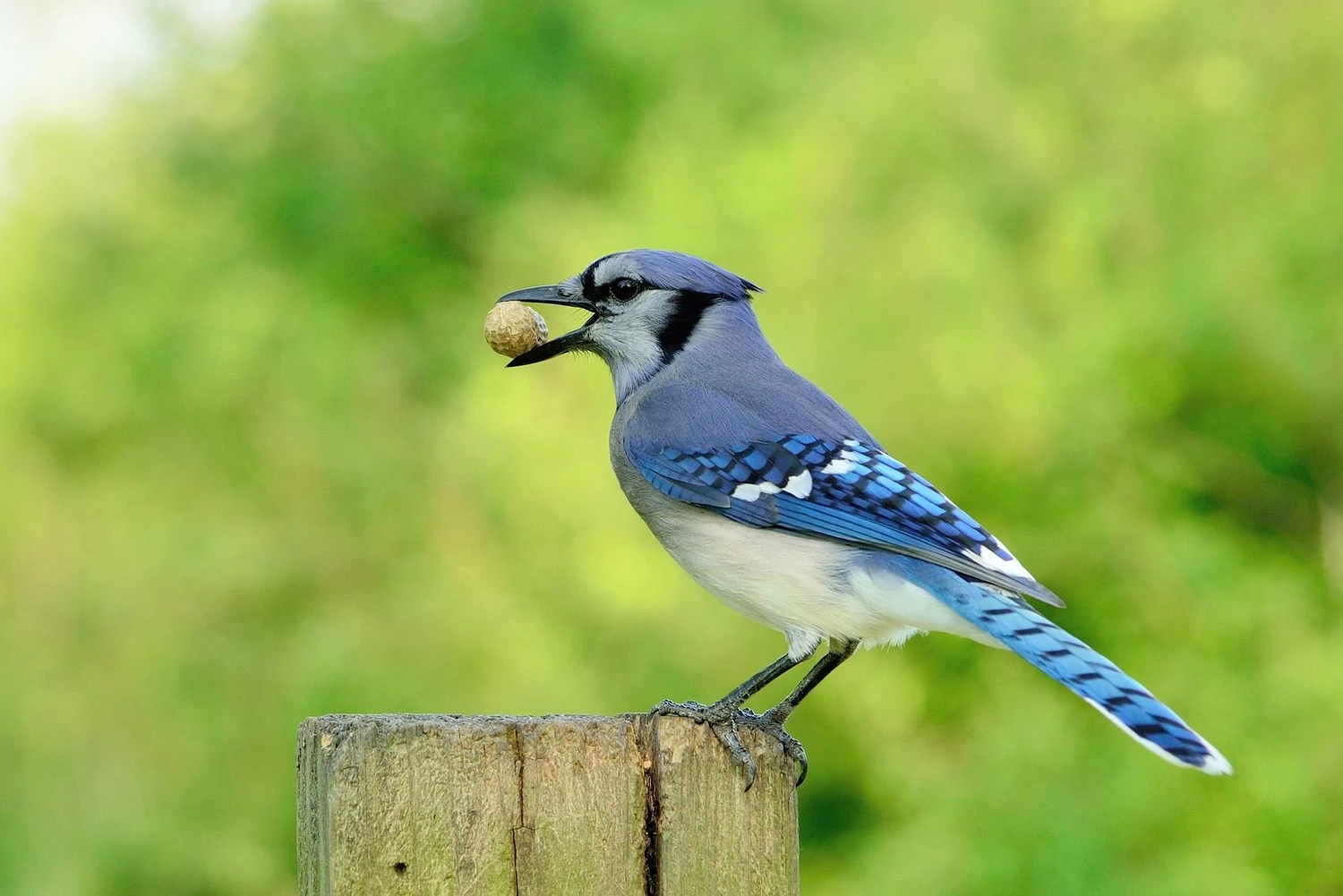
Blue Jays can be spotted all year in Colorado, mainly in the east of the state. They are recorded in 16% of summer and winter checklists.
Blue Jays are common large songbirds with a blue upright crest, blue and black backs, and white undersides.
- Cyanocitta cristata
- Length: 9.8-11.8 in (25-30 cm)
- Weight: 2.5-3.5 oz (70-100 g)
- Wingspan: 13.4-16.9 in (34-43 cm)
Blue Jays live in eastern US states and Southern Canada all year. Some birds will migrate west for winter but not very frequently.
They are noisy birds that travel in family groups eating acorns when available. They can be found in forests, mainly near oak, as they eat acorns. They can also be found in backyards near feeders. As well as acorns, they eat insects, nuts and seeds, and grain. They may also take eggs from nests or take nestlings.
Blue Jay Call:
Blue Jays are large birds and prefer to fly in, grab a peanut or sunflower seed and take it away to feed. They prefer platform or tray feeders to make it easy to make a quick exit.
Attract Blue Jays to your backyard with peanuts, sunflower seeds, and suet. They prefer these on open tray feeders or hopper feeders on a post. They will also enjoy a birdbath.
21. Song Sparrow
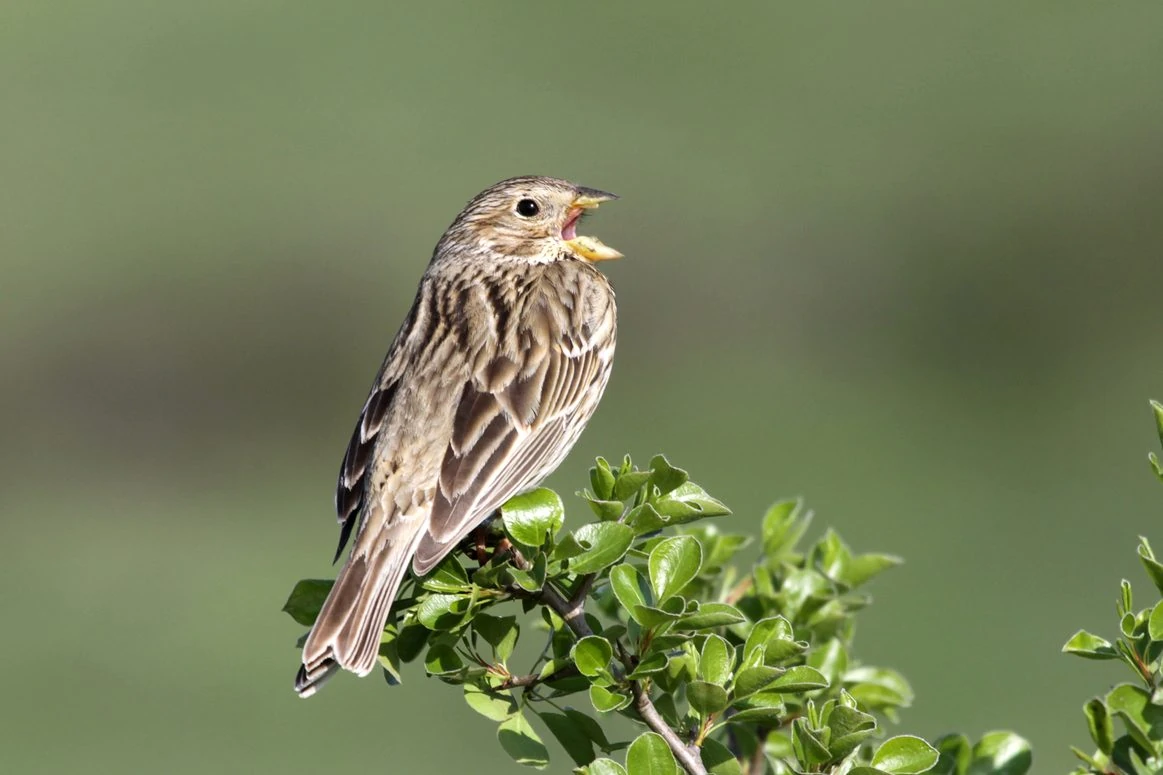
Song Sparrows can be spotted in Colorado all year and are recorded in 18% of summer checklists and 15% of winter checklists submitted by bird watchers for the state.
Song sparrows are not as remarkable looking as other backyard birds, but these predominantly brown-streaked birds use their almost constant song to attract mates in spring and summer.
- Melospiza melodia
- Length: 4.7-6.7 in (12-17 cm)
- Weight: 0.4-1.9 oz (12-53 g)
- Wingspan: 7.1-9.4 in (18-24 cm)
Song Sparrow live all year in the northern US states. Those that breed in Canada migrate to southern US states for winter.
They can be found in open, shrubby, and wet areas, often perched on a low shrub singing. They are often found at backyard feeders.
Song Sparrows eat a wide variety of insects and plants, including beetles, caterpillars, midges, spiders, and earthworms. They will also eat buckwheat, sunflower, raspberries, wild cherries, blackberries, wheat, and rice.
Song Sparrow Song:
Song Sparrow Call:
Attract Song Sparrows to your backyard feeders by putting black oil sunflower seeds, cracked corn, and nyjer on platform feeders.
Sparrows are known as LBJs (Little brown jobs) but if you want to know more, check out this guide to sparrows in Colorado.
22. House Sparrow
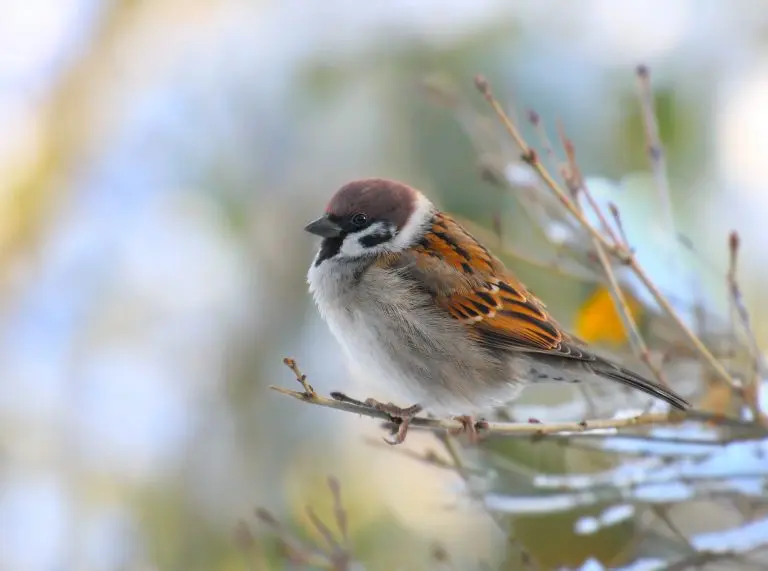
House Sparrows are an introduced species in Colorado that can be spotted here all year. They do not migrate and occur in 17% of both summer and winter checklists for the state.
The House Sparrow is another introduced species that has done very well and is now one of the most common birds. They have gray and brown heads and white cheeks. Their backs are black and brown, and their bellies are gray.
- Passer domesticus
- Length: 5.9-6.7 in (15-17 cm)
- Weight: 0.9-1.1 oz (27-30 g)
- Wingspan: 7.5-9.8 in (19-25 cm)
House Sparrows live in the US and Southern Canada all year.
You can find them near houses and buildings, and they can be pretty tame, and they may even eat out of your hand.
House Sparrows eat mostly grain and seed as well as discarded food. They can be considered a pest because they are non-native, but they are found in backyards even if you do not feed them.
House Sparrow Song:
Attract House Sparrows to your backyard feeders with most kinds of birdseed, including millet, corn, and sunflower seeds.
Brown birds are often overlooked but once you get to know a few you are hooked so get studying all the brown birds in Colorado.
23. Downy Woodpecker
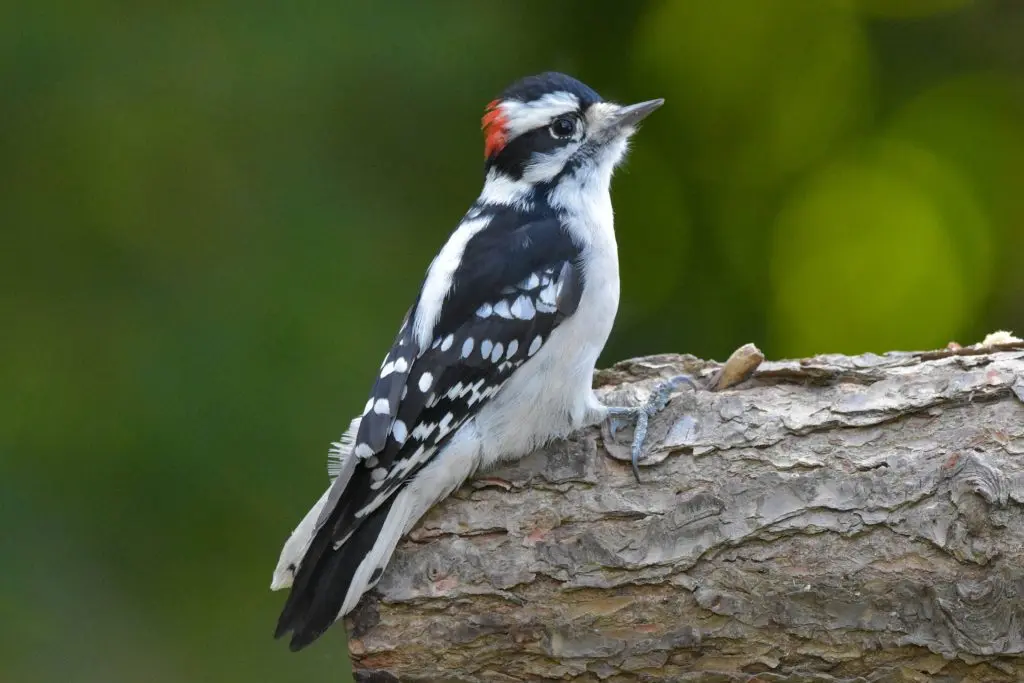
Downy Woodpeckers are common in Colorado, and they are residents of the state all year. They appear in 12% of summer checklists and 16% of winter checklists.
Downy Woodpeckers are small birds that are common at backyard feeders. They are often mixed in with other birds, such as chickadees and nuthatches.
They have black and white coloring with a red patch at the back of their heads. They look similar to the Hairy Woodpecker but smaller.
- Dryobates pubescens
- Length: 5.5-6.7 in (14-17 cm)
- Weight: 0.7-1.0 oz (21-28 g)
- Wingspan: 9.8-11.8 in (25-30 cm)
Downy Woodpeckers do not migrate and can be spotted in most states and provinces, except the north of Canada.
You can find Downy woodpeckers in woodlots, along streams, city parks, and backyards, and they eat mainly insects and beetle larvae, but also berries, acorns, and grains.
Downy Woodpecker Call:
Attract Downy Woodpeckers to your backyard with their favorite treat of suet, but they will also eat black oil sunflower seeds, millet, and peanuts on platform feeders.
24. Mountain Chickadee
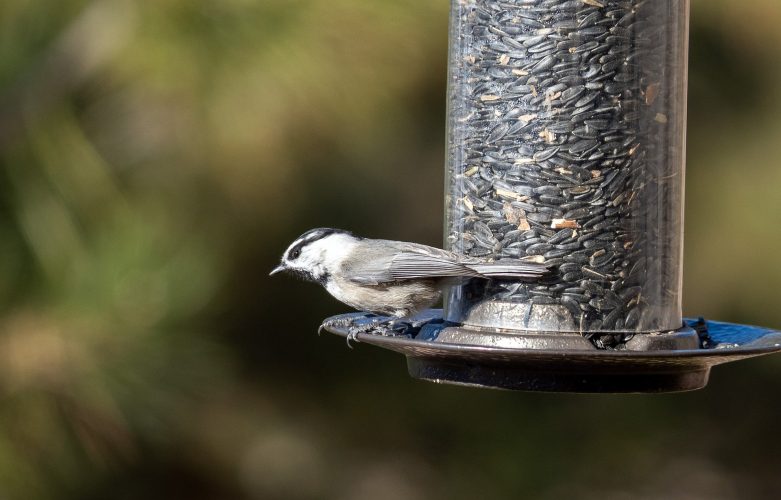
Mountain Chickadees are residents of Colorado all year and are mostly spotted in the west of the state. They appear in 11% of summer checklists and 15% of winter checklists.
Mountain Chickadees are tiny birds with black-and-white heads and gray over the body, darker on the back and light gray underneath.
- Poecile gambeli
- Length: 4.3-5.5 in (11-14 cm)
- Weight: 0.4 oz (11 g)
Mountain Chickadees live in the mountains west of the US all year and do not migrate but may move down the mountain to lower areas in winter.
You can find Mountain Chickadees in evergreen forests, especially those with pine and conifers. They eat insects and spiders, nuts, and seeds and will often visit backyard feeders. Mountain Chickadees will often stash food for later and create a store of food.
Attract Mountain Chickadees to your yard by putting up nest boxes, and they will visit most types of feeders with black oil sunflower seeds, mealworms, nyjer, suet, and peanut butter.
25. Yellow-rumped Warbler
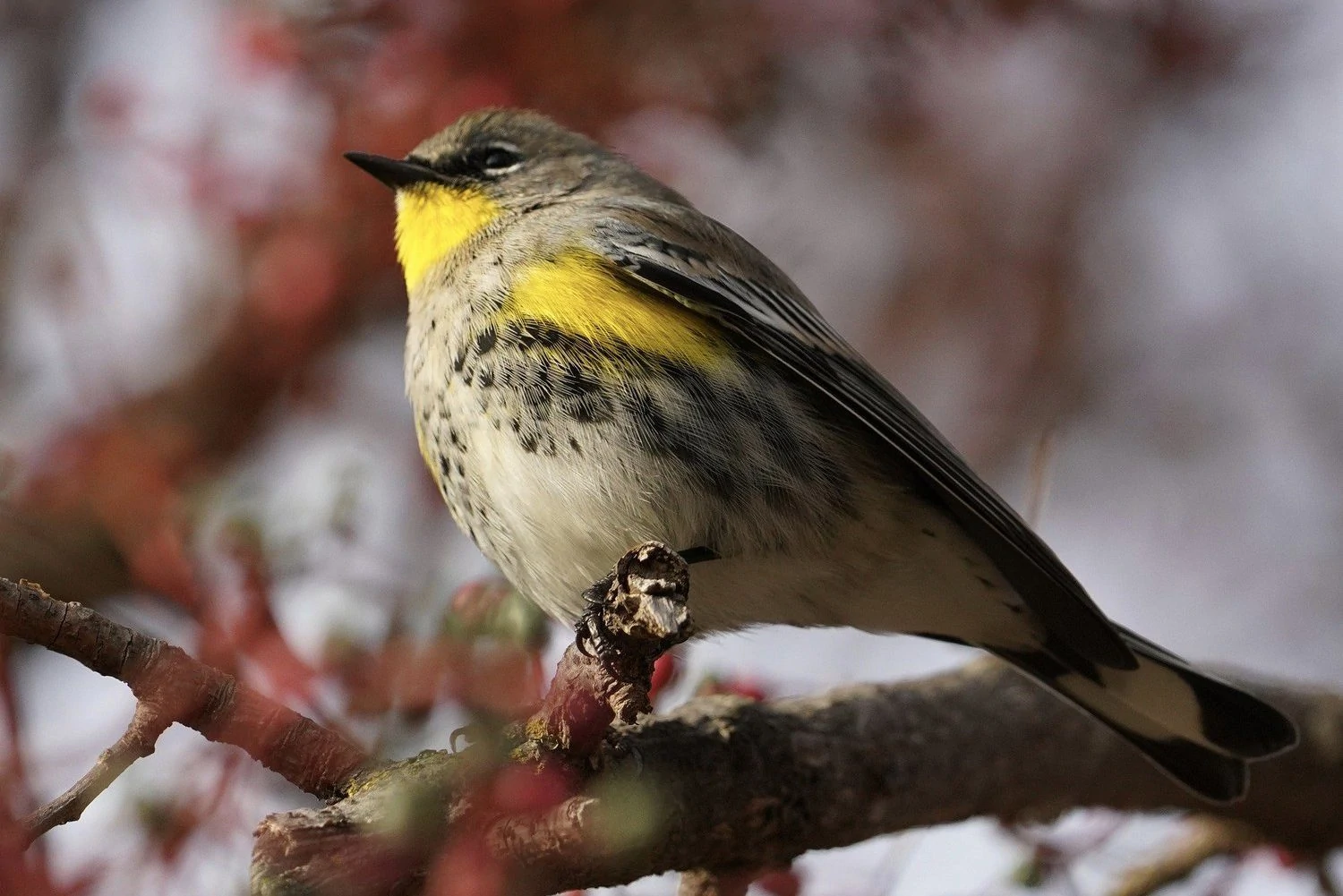
Yellow-rumped Warblers can be spotted during the breeding season in Colorado, but their numbers increase during migrations from April to May and September to October. They are recorded in 20% of summer checklists and up to 53% of checklists during migrations.
Yellow-rumped Warblers are gray with flashes of yellow on the face, sides, and rump and white in the wings.
Females may be slightly brown, and winter birds are paler brown with bright yellow rumps and sides turning bright yellow and gray again in spring.
- Setophaga coronata
- Length: 4.7-5.5 in (12-14 cm)
- Weight: 0.4-0.5 oz (12-13 g)
- Wingspan: 7.5-9.1 in (19-23 cm)
Yellow-rumped Warblers breed predominantly in Canada and parts of the Rockies and the Appalachian mountains.
During migration, they can be seen in the Midwest before overwintering in southern and southwestern US states and the Pacific Coast and into Mexico and Central America.
You can find Yellow-rumped Warblers in coniferous forests, especially during the breeding season. During winter, they can be found in open areas with fruiting shrubs. In summer, they eat mostly insects and on migration, and in winter, they eat mostly fruit, including bayberry and wax myrtle.
Yellow-rumped Warbler Song:
Attract Yellow-rumped Warblers to your backyard with sunflower seeds, suet, raisins, and peanut butter.
These colorful and melodious migratory birds don’t stick around for long so be sure to check out all the warblers in Colorado you can spot before it’s too late.
26. White-breasted Nuthatch
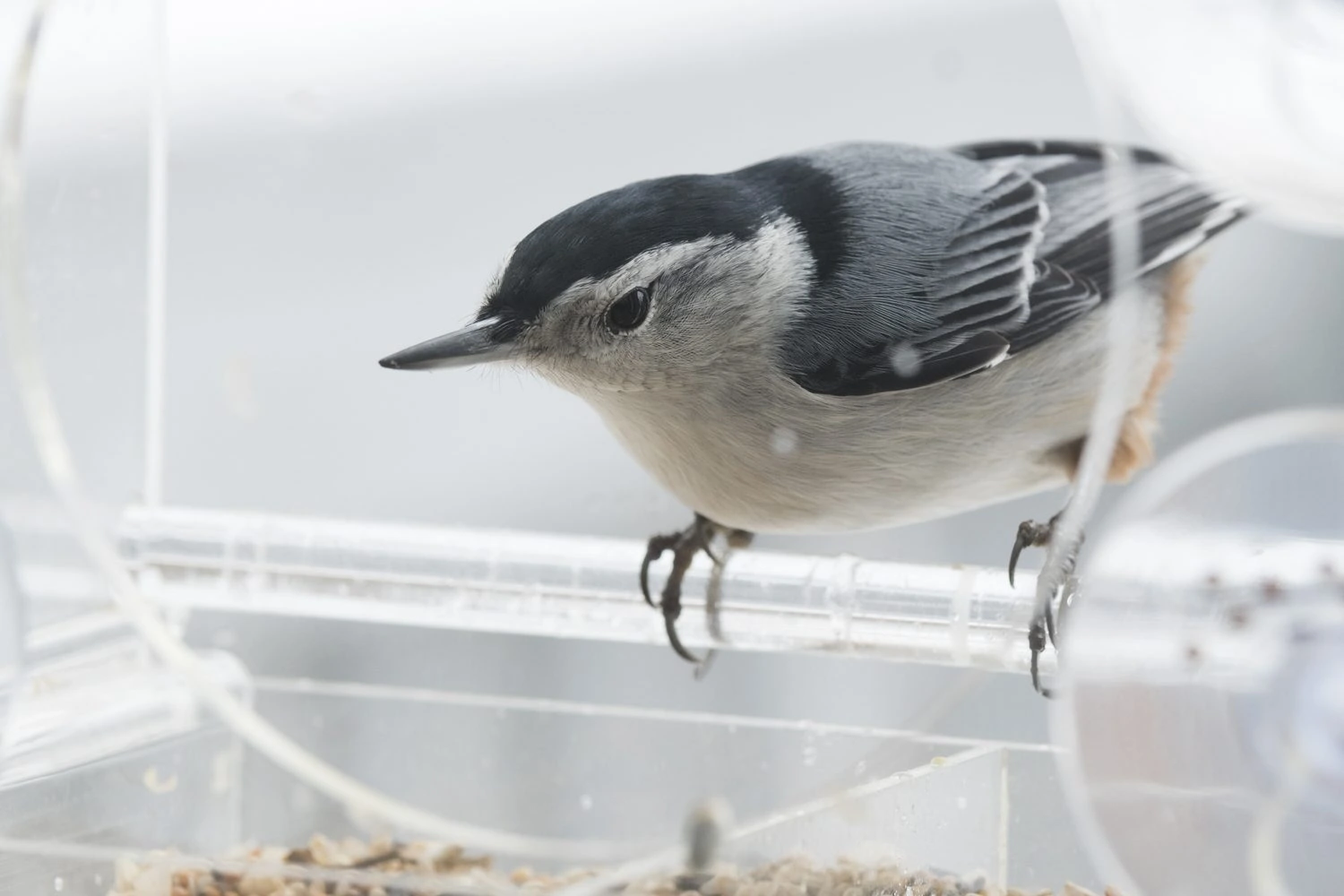
White-breasted Nuthatches do not migrate and live in Colorado all year. They are spotted in 11% of summer checklists and 14% of winter checklists.
White-breasted Nuthatches are active little birds that are gray-blue on the back and white on the face and belly, with a black cap. They will often have a chestnut color on the lower belly and under the tail.
- Sitta carolinensis
- Length: 5.1-5.5 in (13-14 cm)
- Weight: 0.6-1.1 oz (18-30 g)
- Wingspan: 7.9-10.6 in (20-27 cm)
White-breasted Nuthatches live all year in the US and southern Canada.
You can find White-breasted Nuthatches in deciduous forests, woodland edges, parks, and yards with trees or at feeders. They mainly eat insects, including beetles and their larvae, caterpillars, ants, and also spiders.
White-breasted Nuthatches also eat seeds and nuts, including acorns, hawthorns, sunflower seeds, and sometimes corn crops. They jam large nuts and acorns into tree bark and then whack them with their bills to open or ‘hatch’ them to get the seed out.
White-breasted Nutcracker Call:
Attract White-breasted Nuthatches to your backyard with sunflower seeds and peanuts on tube feeders or suet feeders.
27. Spotted Towhee
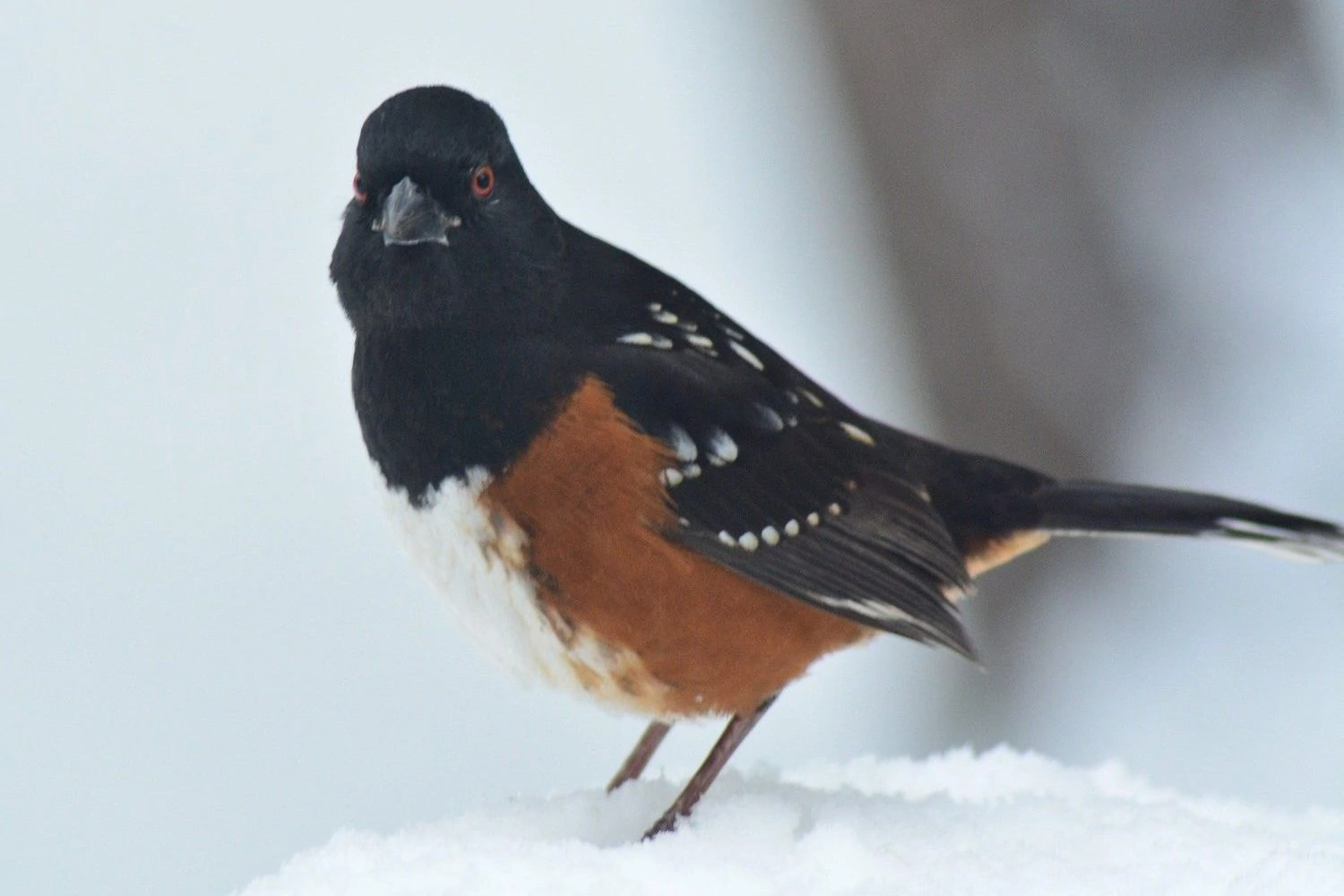
Spotted Towhees can be spotted in Colorado all year, but they are more common during the breeding season, from April to October. They appear in 18% of summer checklists and 8% of winter checklists.
Spotted Towhees are large sparrows that are black on their head, throat, and back in the males and brown in the females. Both males and females have reddish-brown sides, white bellies, and white spots on the wings and back. They have long tails and are about the size of a Robin.
- Pipilo maculatus
- Length: 6.7-8.3 in (17-21 cm)
- Weight: 1.2-1.7 oz (33-49 g)
- Wingspan: 11.0 in (28 cm)
Spotted Towhees live in western US states, but those in the interior of the north migrate south after breeding to Texas and surrounding areas.
You can find Spotted Towhees on the ground in dense tangles of shrubs scratching around for insects, including beetles, crickets, grasshoppers, caterpillars, wasps, and bees. They also eat acorns, berries, and seeds.
Spotted Towhee Song:
Attract Spotted Towhees to your yard if you leave overgrown borders, and they will visit platform feeders or ground feeders for black oil sunflower seeds, hulled sunflower seeds, cracked corn, millet, and milo.
28. White-crowned Sparrow
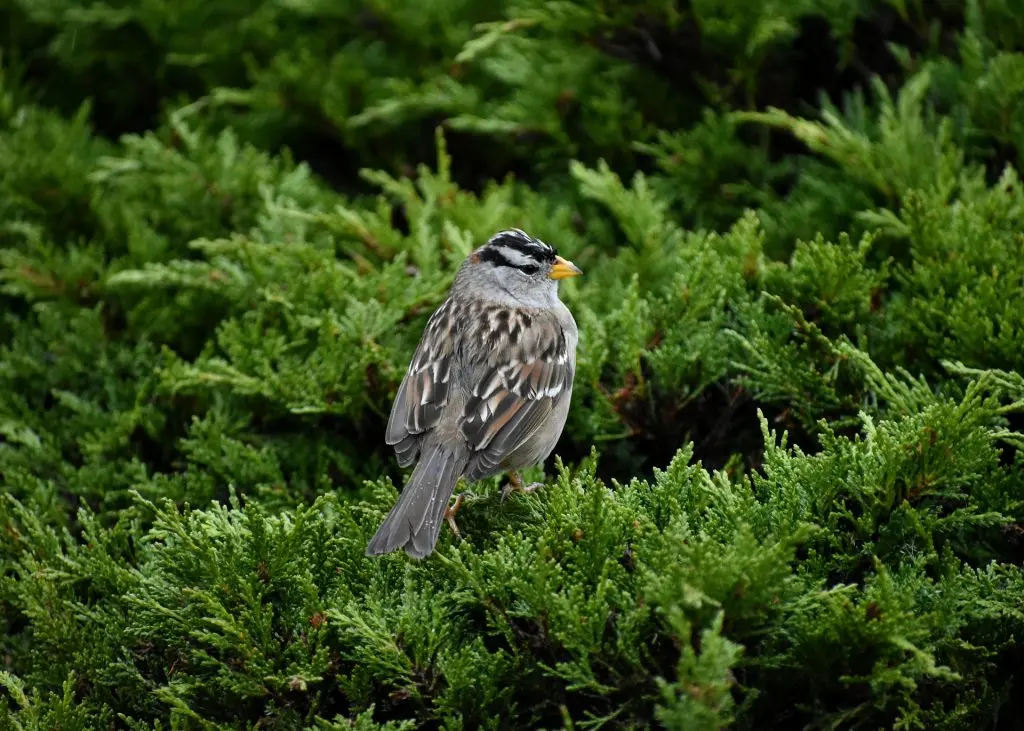
White-crowned Sparrows can be spotted all year in Colorado and are recorded in around 10% of summer and winter checklists for the state.
White-crowned Sparrows are large grayish sparrows with long tails, small bills, and bold black and white stripes on their heads.
- Zonotrichia leucophrys
- Length: 5.9-6.3 in (15-16 cm)
- Weight: 0.9-1.0 oz (25-28 g)
- Wingspan: 8.3-9.4 in (21-24 cm)
White-crowned Sparrows breed in Alaska and arctic Canada before heading south to the lower 48 and Mexico for winter. However, some may remain along the Pacific Coast and the mountainous west all year.
You can find White-crowned Sparrows in weedy fields, along roadsides, forest edges, and in yards foraging for seeds of weeds and grasses or fruit such as elderberries and blackberries.
White-crowned Sparrow Song:
Attract White-crowned Sparrows to your backyard with sunflower seeds, and they will also eat seeds that other birds drop at feeders.
29. Chipping Sparrow
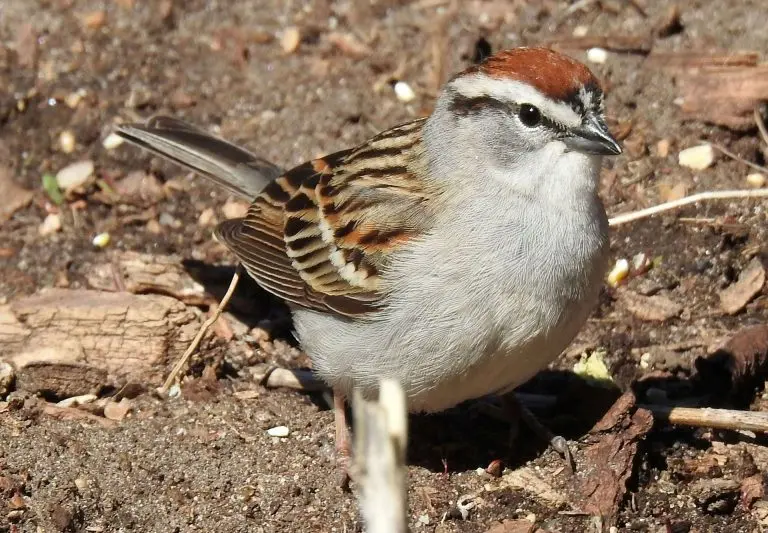
Chipping Sparrows are frequently spotted in Colorado during summer and are recorded in 15% of checklists at this time. They spend the breeding season here mostly from April to October.
Chipping Sparrows are slender, long-tailed birds with a grayish belly and brown and black-streaked back, with a rusty crown and black eye line. In winter, the colors are more subdued.
- Spizella passerina
- Length: 4.7-5.9 in (12-15 cm)
- Weight: 0.4-0.6 oz (11-16 g)
- Wingspan: 8.3 in (21 cm)
Chipping Sparrows spend their summer breeding in the US and Canada before flying to Mexico and Florida for winter. Some remain all year in the southern states.
You can find Chipping Sparrows in small flocks on open ground and will come to backyards for many kinds of birdseed.
Chipping Sparrow Song:
Attract Chipping Sparrows to your backyard with seeds or cracked corn on open feeders such as hoppers or platforms.
30. Lesser Goldfinch
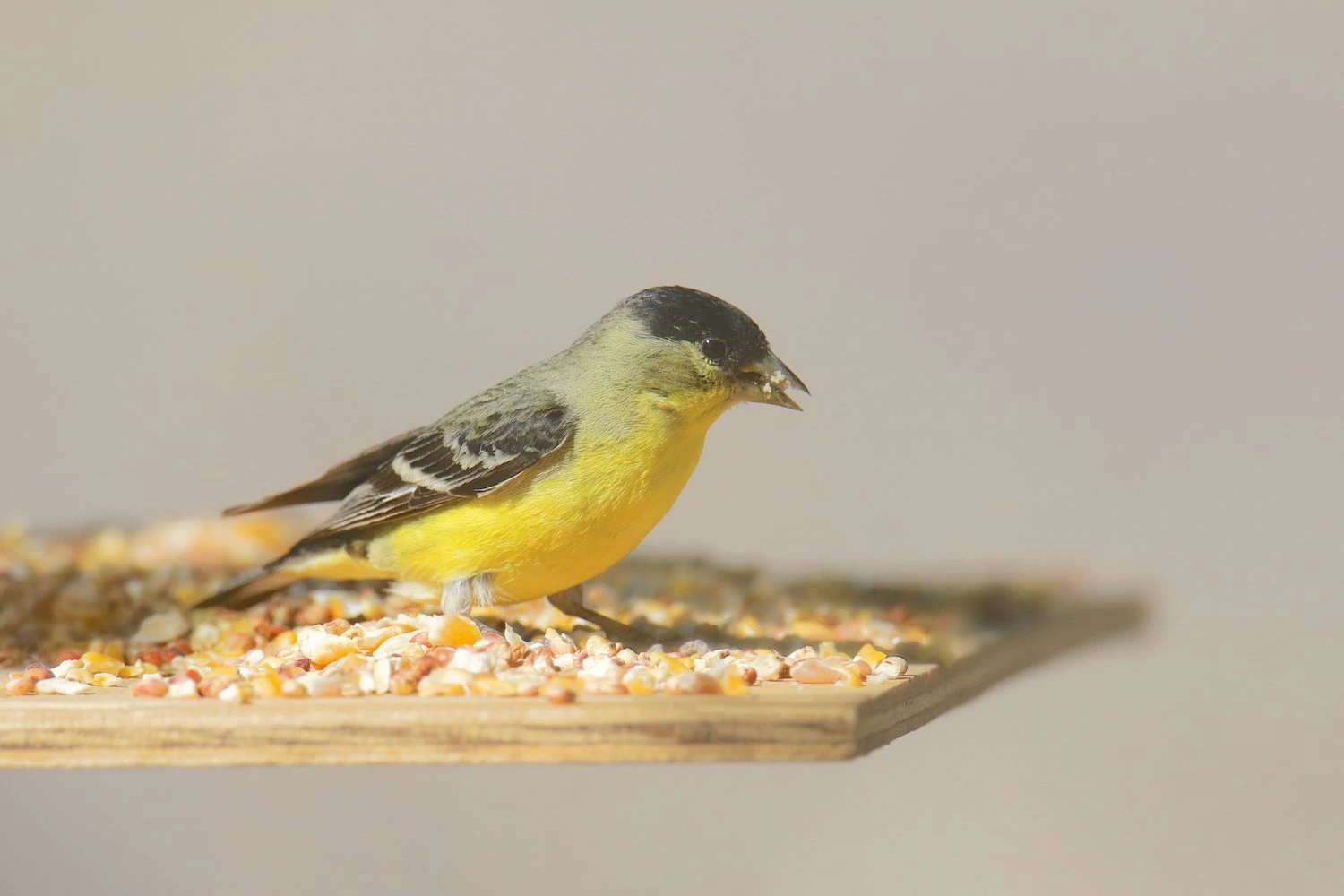
Lesser Goldfinches spend the breeding season in Colorado and are mainly seen from June to September. They occur in 11% of summer checklists. However, some do hang around here all year.
Lesser Goldfinches are tiny bright yellow and black songbirds with long pointed wings and short notched tails. Females have olive backs and are more dull yellow underneath.
- Spinus psaltria
- Length: 3.5-4.3 in (9-11 cm)
- Weight: 0.3-0.4 oz (8-11.5 g)
- Wingspan: 5.9-7.9 in (15-20 cm)
Lesser Goldfinches live in the southwestern US states and the West Coast all year, but those that breed in the interior of western US states migrate for winter.
Lesser Goldfinches can be found in large flocks in open habitats, including thickets, weedy fields, forest clearings, parks, and gardens. They forage for seeds, especially sunflower seeds, but also fruits from elderberry, coffeeberry, and buds from cottonwoods, willows, sycamores, and alders.
Lesser Goldfinch call/Song:
Attract Lesser Goldfinches to your yard with sunflower seeds and nyjer in tube feeders or platform feeders.
Common Birds at Different Times of Year in Colorado
The birds that are attracted to backyards in Colorado change throughout the year. The lists below show the backyard birds most commonly seen at different times of the year in Colorado.
These are the backyard birds most often seen in Colorado that may visit your lawn or feeders. In addition, they are the birds that appear most frequently on state checklists on ebird. The data combines birds most commonly spotted in Colorado in summer (June and July) and winter (December and January).
Birds that are not often seen at feeders or backyards were removed to give you the birds in Colorado you are most likely to see from home.
This data mix ensures that whatever time of year you are bird-watching in Colorado, these are the birds you will most likely spot at feeders or on your lawn.
Common birds in Colorado all year
American Robin 39%
Northern Flicker 35%
House Finch 34%
Dark-eyed Junco 30%
Black-billed Magpie 30%
Black-capped Chickadee 29%
Red-winged Blackbird 28%
American Crow 26%
European Starling 24%
Eurasian Collared-Dove 22%
Summer birds Colorado
American Robin 51%
Mourning Dove 35%
Broad-tailed Hummingbird 33%
Red-winged Blackbird 31%
Northern Flicker 30%
House Wren 29%
House Finch 29%
Black-billed Magpie 24%
Barn Swallow 24%
Yellow Warbler 21%
Winter birds Colorado
Dark-eyed Junco 60%
House Finch 36%
Northern Flicker 35%
Black-capped Chickadee 34%
Black-billed Magpie 34%
American Crow 29%
European Starling 24%
American Robin 23%
Eurasian Collared-Dove 21%
Song Sparrow 17%
Best Bird Feeders to Attract Birds in Colorado
A variety of different bird feeders will attract the most species of birds
- Tube Feeders can be filled with different types of birdseed, and depending on the seed, different birds will be attracted. Black oil sunflower seeds attract Goldfinches, Chickadees, Woodpeckers, Nuthatches, and Pine Siskins.
- Ground Feeders or a tray below a Tube Feeder with Black oil sunflowers tube feeders attract Cardinals, Jays, Finches, and Sparrows.
- Platform feeders with Millet or Corn attract small and medium-sized birds such as sparrows, Blackbirds, Towhees, Juncos, Doves, Grackles, and Starlings.
- Peanut feeders attract Woodpeckers, Chickadees, Nuthatches, Titmice, Jays, Juncos, Finches, and Sparrows.
- Suet Feeders are great, especially in winter, for Woodpeckers, Cardinals, Nuthatches, Kinglets, Wrens, and Chickadees.
- Hummingbird feeders attract these tiny fascinating birds, but they also attract other birds too.
How to Attract Birds to Your Yard in Colorado
If you would like to attract more birds to your yard in Colorado, there are some tips:
- Provide bird feeders for different types of birds to get the most species to visit your yard.
- Provide a water feature such as a birdbath fountain or stream. Ensure that the water is clean and not stagnant
- Grow native plants that will provide food and shelter. Plants, trees, and shrubs provide fruit, berries, and nuts. Blackberries, wild grasses, elderberries, serviceberries, Oaks, Beeches, Cherries, sumacs, hemlocks, Purple Coneflowers, Sunflowers, Milkweed, Cardinal Flowers, Trumpet Honeysuckle, Virginia Creeper, Buttonbush, and Dogwoods.
- Let your grass grow long to provide cover and seeds.
- Leave a brush pile to provide food, protection, and nesting opportunities for birds.
- Don’t use pesticides and herbicides as these may be toxic to birds and prevent the natural foraging opportunities for insects and seeds that birds will seek in your yard.
- Set up nest boxes to attract breeding birds and ensure they are cleaned every year.
How to Identify Birds in Colorado
Here are some tips to help you identify birds:
- Size – Size is the easiest thing to notice about a bird. Birds are often measured in inches or centimeters in guide books. It’s best to take a note of the bird in terms of small, medium, or large to be able to look for it later. A small bird is about the size of a sparrow, a medium bird is about the size of a pigeon, and a large bird is the size of a goose.
- Shape – Take note of the silhouette of the bird and jot it down or draw the outline. Look at tail length, bill shape, wing shape, and overall body shape.
- Color pattern – Take a note of the main color of the head, back, belly, wings, and tail for the main color and then any secondary colors or patterns. Also, take note of any patterns such as banding, spots, or highlights.
- Behavior – Are they on the ground or high up in the trees. Are they in flocks or on their own? Can you spot what they are eating?
- Habitat – Woodlands, parks, shrubs, grasslands or meadows, shore or marsh.
- Use a bird identification app such as those created by ebird or Audubon
Birds to Spot if Out Birding in Colorado
If you go out Birding in Colorado, these are other birds that you may be able to spot.
This guide about hawks in Colorado will help.
- Canada Goose
- Mallard
- Great Blue Heron
- Bald Eagle
- Red-tailed Hawk
- Double-crested Cormorant
- Bufflehead
- Killdeer
- Violet-green Swallow
- Belted Kingfisher
- Green-winged Teal
- Pied-billed Grebe
- Tree Swallow
- Common Goldeneye
- Horned Grebe
- Rufous Hummingbird
- Black-headed Grosbeak
- Northern Harrier
- Northern Shoveler
- Osprey
- American Kestrel
- California Quail
- Orange-crowned Warbler
- Turkey Vulture
- Burrowing Owl
- Rough-legged Hawk
- Sandhill Cranes
- Snowy Egret
- White-faced Ibis
- Golden Eagle

